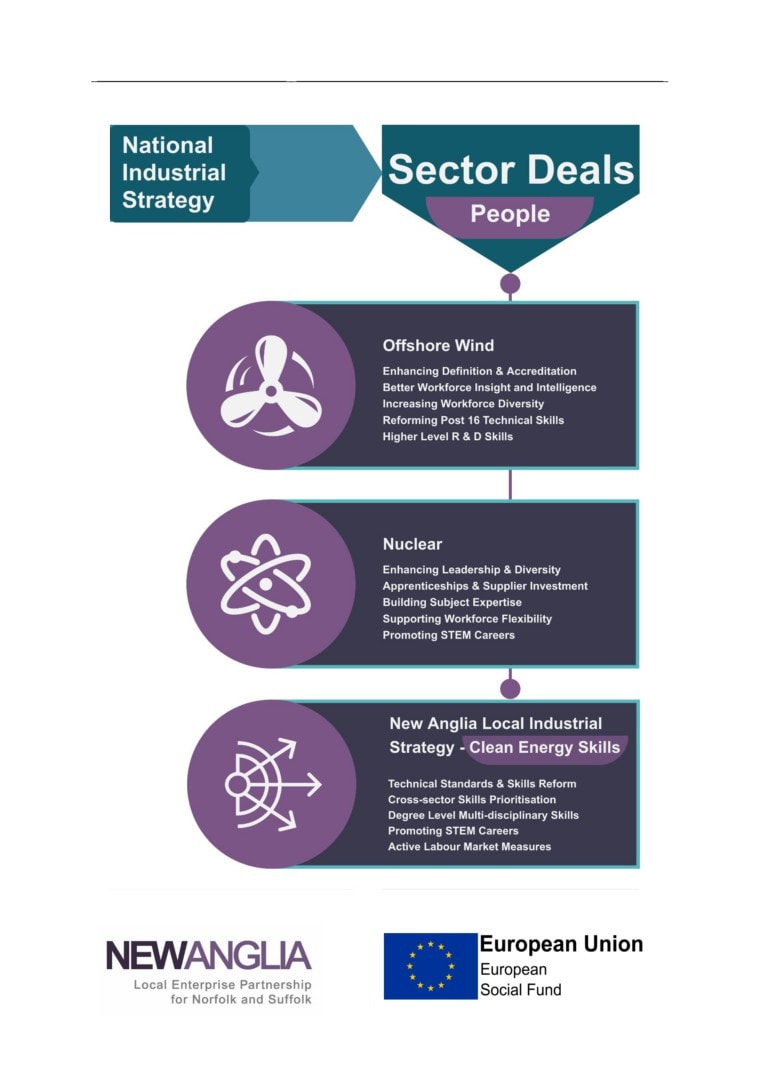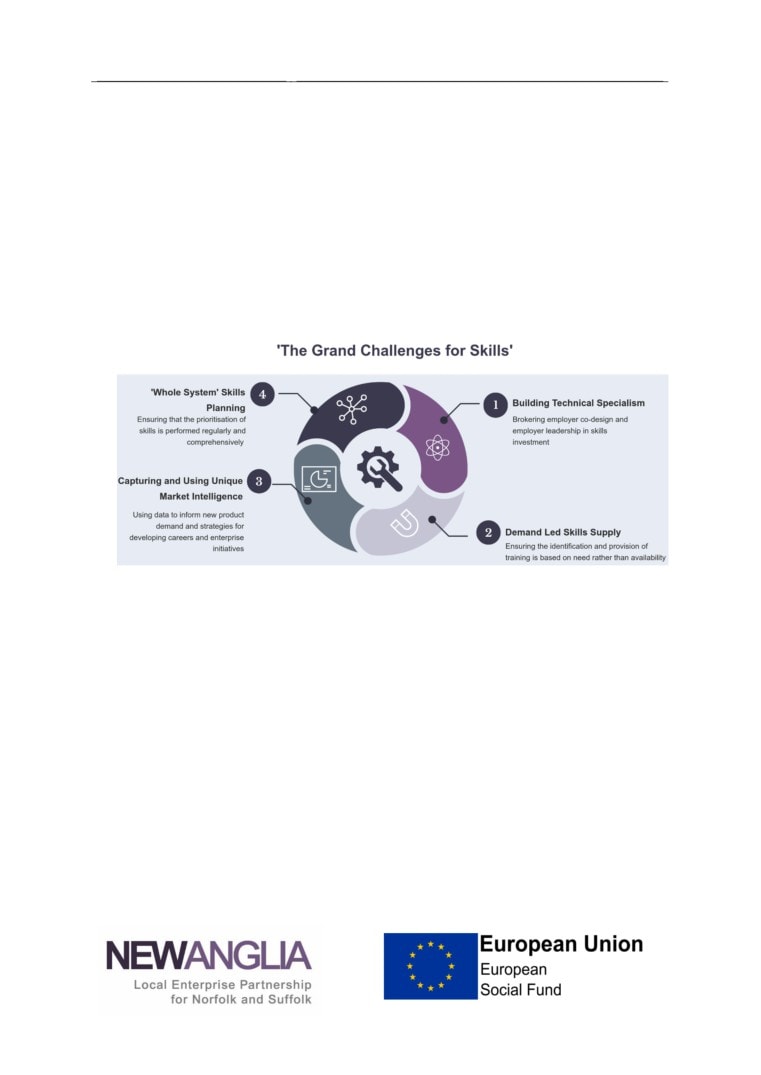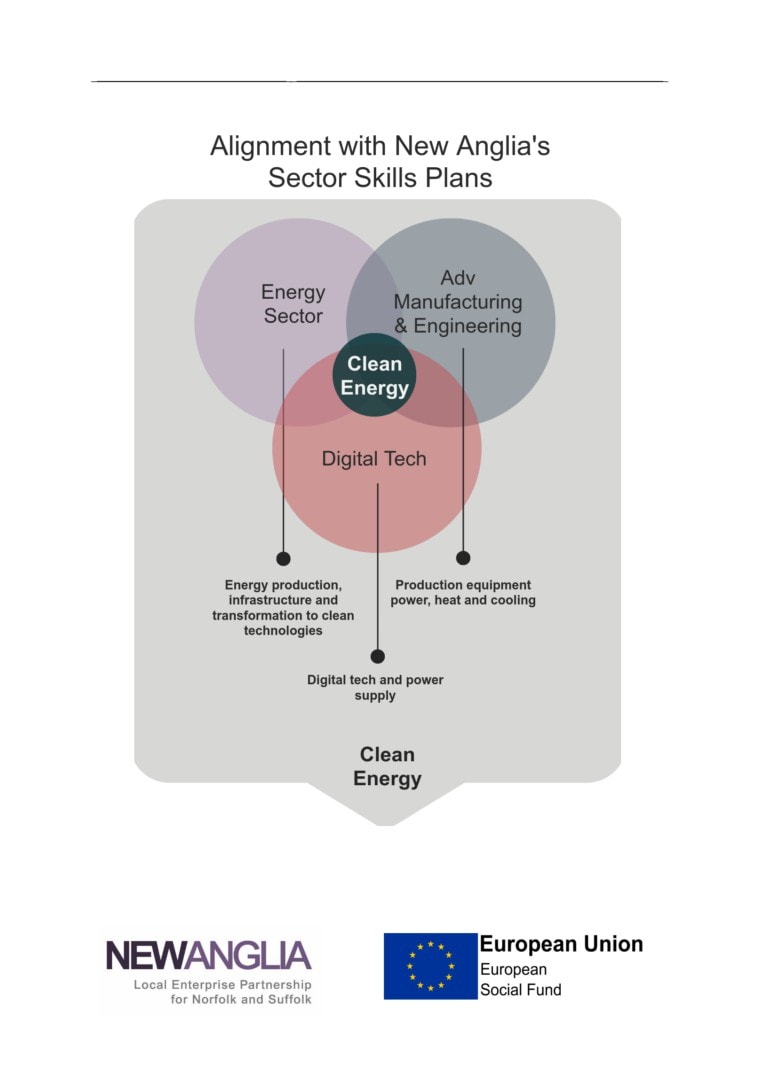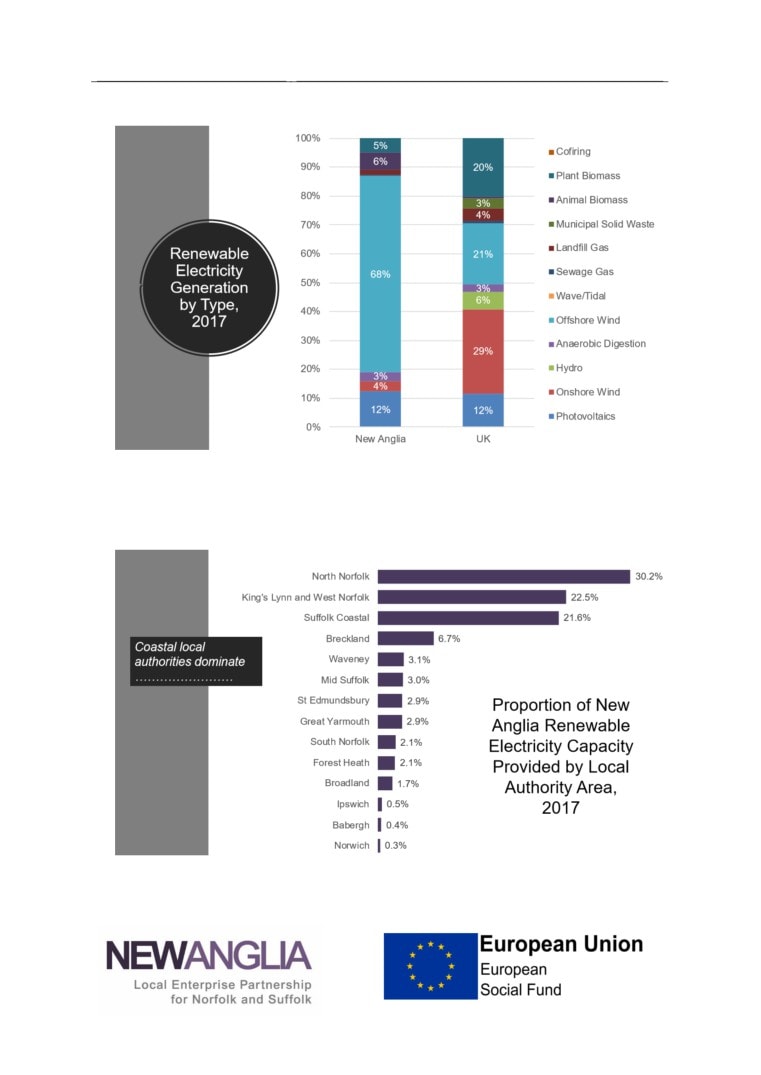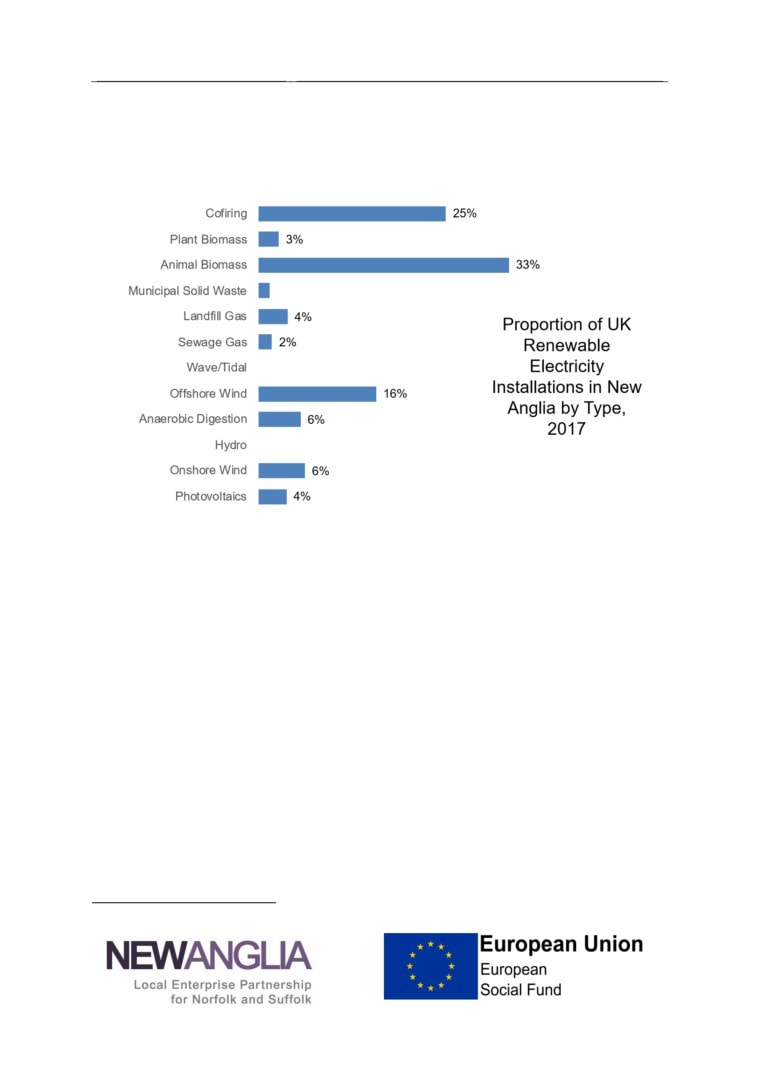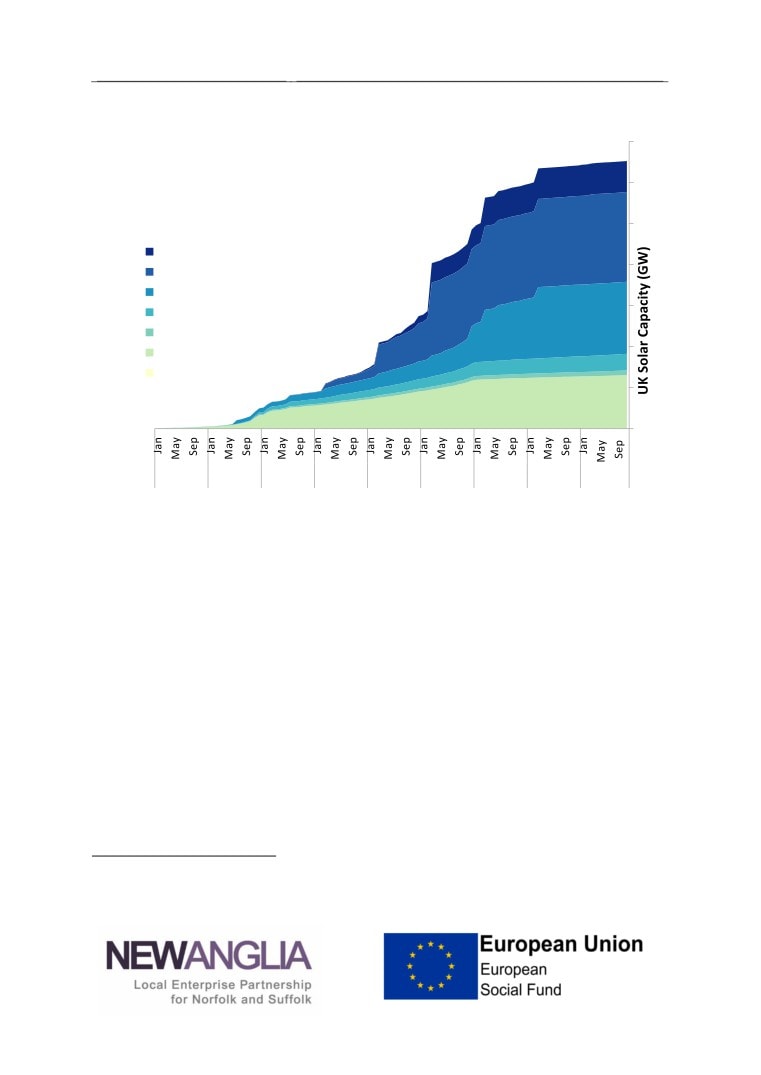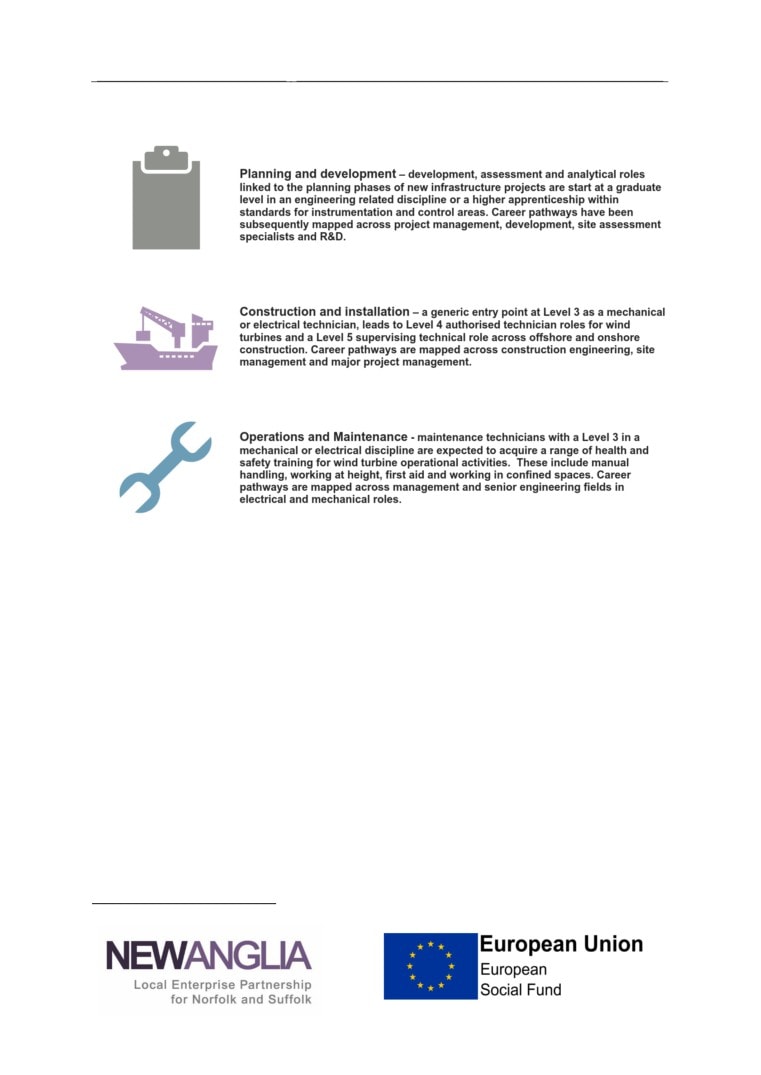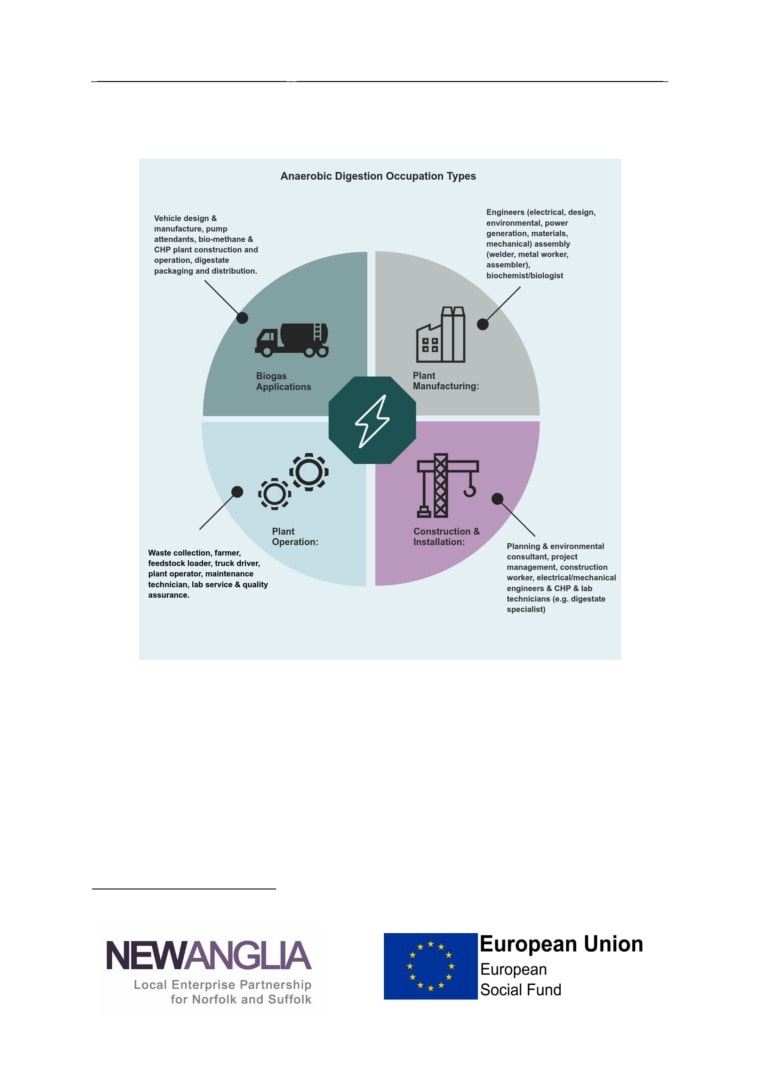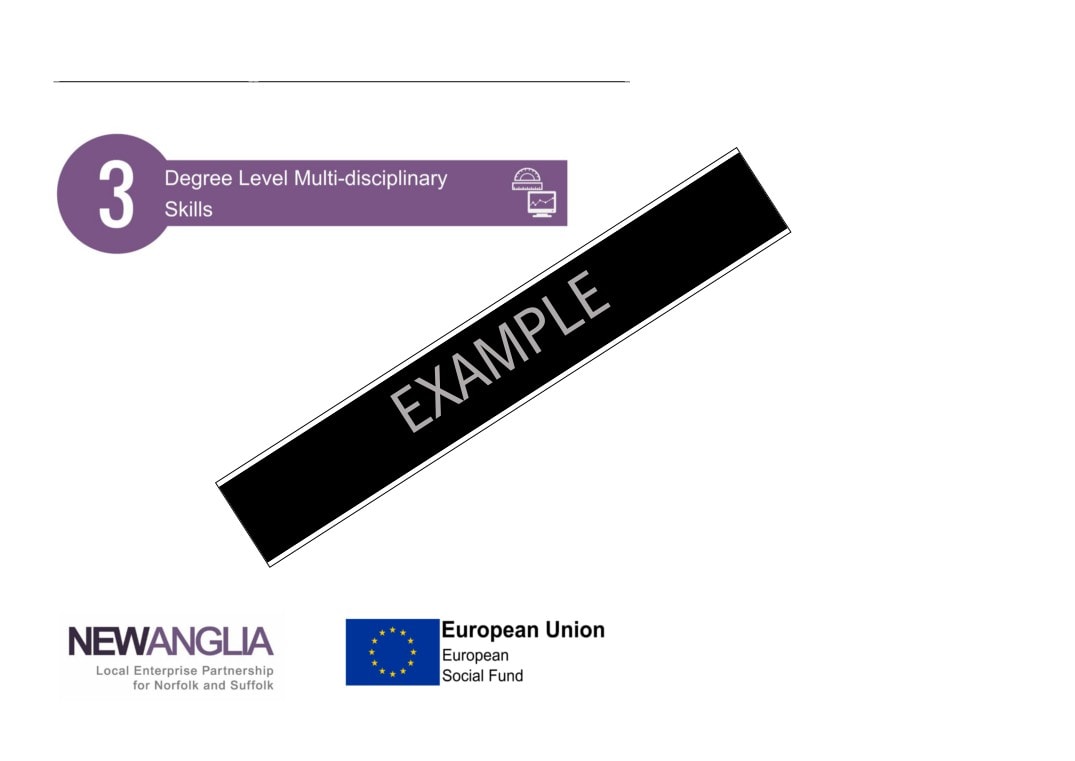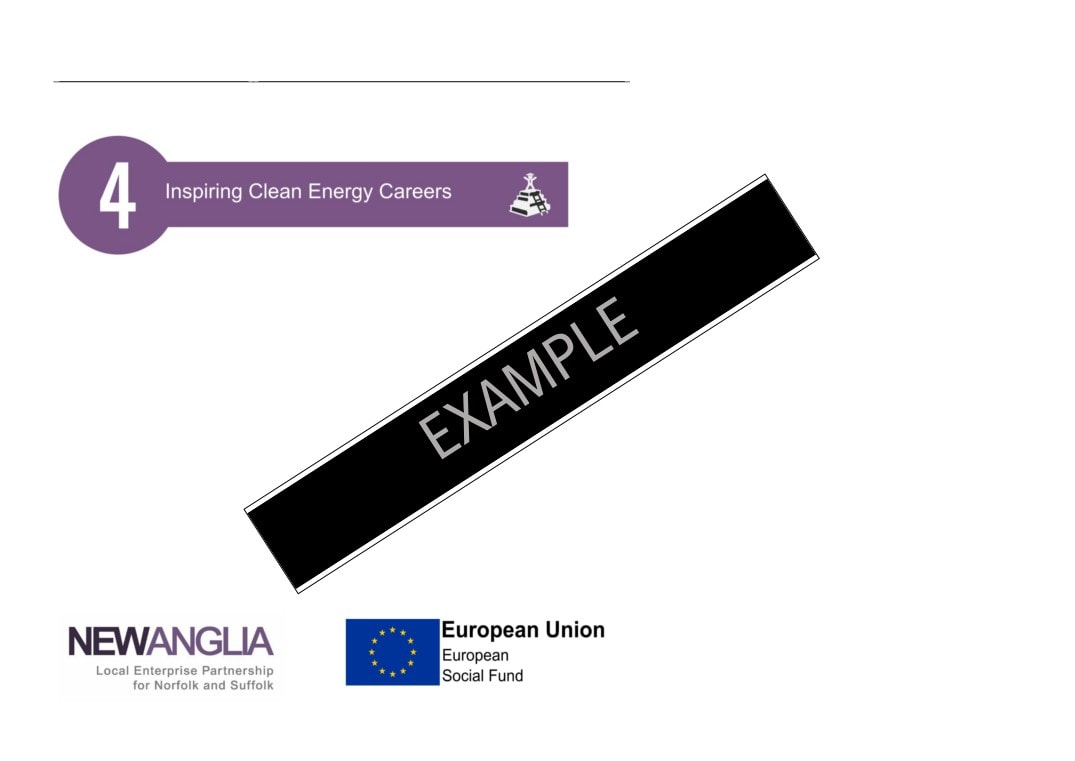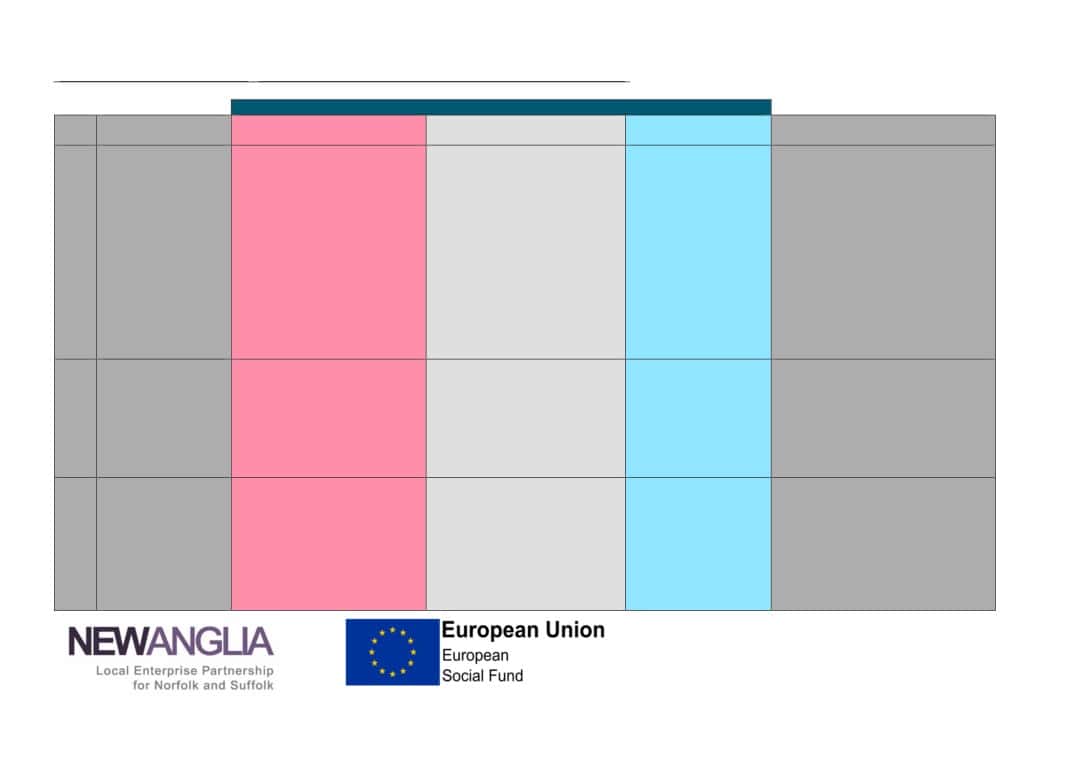Page 1
New Anglia LEP
Clean Energy Skills Plan, March 2019
Enabling Growth in
New Anglia Clean Energy
Industry through Skills
Development
2019-‘36
LEP Officer Version
A Skills Plan for New Anglia
March 2019
Page 2
New Anglia LEP
Clean Energy Skills Plan, March 2019
Table of Contents
Executive Summary
4
Background Context
16
1. Clean Energy Skills Plan Priorities
17
Sector Deals
17
Reforming the Skills System- The Grand Challenges for Skills
19
Alignment with other Sector Skills Plans
20
Priority Skills Actions to be Taken
22
2. Defining the Clean Energy Theme and Growth Opportunity
36
Low Carbon and Renewable Energy (LCRE)
36
National Support for the LCRE Sector
37
UK Clean Growth Strategy
38
International Potential
39
3. The New Anglia Local Industrial Strategy and Clean Energy
41
The Local Industrial Strategy
41
Renewable Electricity Generation
44
Biomass and Bio-energy
47
Solar
49
Nuclear
50
Future Technologies for Generation and Storage
52
Energy Efficiency Transformation
53
Infrastructure and Energy Grids
54
New Anglia USP for Clean Energy
55
Capex and Opex
57
The Enabling Role of Skills and Innovation
58
4. Clean Energy Implications for Employment and Skills
60
Employment
60
Workforce and Skills
61
Oil & Gas - Transitional Skills for Supply to Clean Energy
63
Carbon Capture, Use and Storage (CCUS)
64
Wind, Wave and Tidal
65
Biomass
67
Alternative Fuels & Electric Vehicles
67
Page 3
New Anglia LEP
Clean Energy Skills Plan, March 2019
Solar
68
Geo-thermal
68
Nuclear
69
Anaerobic Digestion
71
Annex 1 - Clean Energy Skills Plan Action Matrix
73
Annex 1 - Clean Energy Skills Plan Action Matrix
74
Annex 2 - Existing Course Provision for Energy and Clean Energy
93
Annex 3 - Energy Policy - Extract from BEIS departmental plan
97
Annex 4 - Carbon Brief report
100
Page 4
New Anglia LEP
Clean Energy Skills Plan, March 2019
Executive Summary
1. Introduction
Background
This document sets out a Skills Plan to support ambitions for the local Low Carbon and
Renewable Energy sector, while also delivering against the bigger picture of Clean Energy,
which has been identified as one of Norfolk and Suffolk’s three key market opportunities for
the Local Industrial Strategy, alongside Agri Food and ICT.
Local Industrial Strategies focus on distinctive economic strands where an area can
demonstrate a competitive advantage and is able to play a significant national role in
delivering productivity growth against the UK Industrial Strategy1
low carbon
reduce the
electricity
carbon
low carbon heat
intensity of the
energy from waste
economy by
and biomass
holistically
energy efficient
addressing
products
generation,
low carbon
services
distribution and
consumption of
low emission
vehicles
clean energy
Ambitions
Norfolk and Suffolk has ambitions to build its reputation as a Centre of Excellence for Clean
Energy skills, by developing best-in-class elements such as :
• Operations + Maintenance Excellence
• Skills transfer
• Inspiring Clean Energy Careers
• A local and diverse talent pipeline and workforce
• Test bedding for emerging skills needs
• Multi-disciplinary local learning programmes
1 UK Government (2017), Industrial Strategy: The Grand Challenges
Page 5
New Anglia LEP
Clean Energy Skills Plan, March 2019
People are identified as one of the key pillars for growth in the UK’s Industrial Strategy and
by placing skills development at the heart of the Norfolk and Suffolk Clean Energy theme in
the Local Industrial Strategy, economic ambitions will be supported by increasing the
number of high value, higher skilled and higher paid jobs supported in Clean Energy, to
increase Clean Energy GVA in Norfolk and Suffolk.
2. Economic analysis
World-leaders in clean energy
Norfolk and Suffolk is recognised nationally and internationally for its Low Carbon and
Renewable Energy (LCRE) activities and for its contribution and commitment towards the
broader agenda of Clean Energy, where the
focus is on enabling a transition to a low carbon
energy system through capacity building in low
carbon generation, distribution and efficiency.
£1bn value
Nationally, the energy sector is in transition,
with over 50% of power now coming from LCRE
sources and further substantial expansion
2,000 businesses
expected as the UK seeks to lead the world in
decarbonising energy supply.
5300 jobs
Norfolk and Suffolk is unique amongst UK
regions in having strengths in the full range of
major clean energy technologies and is a leader
in:
£193K value per job
•
Offshore renewable energy
•
Bioenergy and solar
Norfolk and Suffolk renewable energy and
•
Nuclear
low carbon economy, 2016
The strengths of the area as a leader in Clean
Energy have been built upon:
• the natural advantages of its coastal and agricultural topography;
• A long history of investment in nuclear power generation at Sizewell and in the
offshore oil and gas industry in the southern North Sea;
• The commitment made locally to invest in the low carbon and renewables sector
from the start of the new Millennium
Page 6
New Anglia LEP
Clean Energy Skills Plan, March 2019
Local policy support for commercial investment has helped
to establish Norfolk and Suffolk as national leaders in
renewable energy, with specialist innovation centre Orbis
Energy providing support and the East of England Energy
48%
Group and the New Anglia All Energy Industry Council giving
a voice to the economy.
The increase in renewable
Currently, Norfolk and Suffolk generates 43% of the UK’s
energy generation in Norfolk
animal biomass energy production and 27% of wind power
and Suffolk between 2014-17
and renewable energy generation increased overall by 48%
between 2014-17.
Building prowess : the opportunities for future economic success
The International Energy Agency has calculated that to meet the targets agreed by 195
countries in Paris in 2015, $13.5 trillion of investment is needed globally in new generation
capacity, demonstrating the size of the global market and the huge export opportunities
offered by the industry.
The national Clean Growth Strategy (2018)2 highlights substantial growth in the UK’s low
carbon economy, reporting that since 1990 UK GDP has grown by 67%, the fastest rate in
the G7, whilst carbon emissions have fallen by 42%, much faster than the 3% reduction
seen in the G7 countries
The UK low carbon economy is expected to grow nationally by 11% each year through to
2030, which is four times faster than the overall economy, giving the potential for between
£60-170billion of exports of low carbon goods and services by 2030.
Norfolk and Suffolk is the only region in the UK which is strong in all areas of LCRE energy
generation and in building the market opportunity of Clean Energy through the Local
Industrial Strategy, the objective is to support both the:
• Energy Industry - to grow the productivity and economic contribution of the energy
industry to position Norfolk and Suffolk as a leading global centre for Clean Energy
technology and deployment;
• Wider economy - to enable economic growth across the economy by ensuring that the
area offers a modern energy infrastructure and affordable, sustainable energy supplies
to facilitate growth.
The strategy for Clean Energy developments builds upon existing core strengths, including:
Wind
The Southern North Sea, with Norfolk and Suffolk at its centre, is currently the largest
offshore wind development zone in the World with the Government’s Offshore Wind Sector
Deal3 setting out ambitions to grow offshore wind capacity in the UK to 30GW by 2030 at a
cost of £40billion.
2 UK Government (2018), Clean Growth Strategy
3 HMG (2019), Industrial Strategy, Offshore Wind Sector Deal
Page 7
New Anglia LEP
Clean Energy Skills Plan, March 2019
Of this, the East of England would deliver almost half of the capacity, representing a five-fold
increase in installed capacity in just over a decade. This would add a further 27,000 jobs
nationally by 2030 and the aspiration is
GLOBAL POTENTIAL
for one third of the staff to be female by
that time.
The case for clean energy
Predictions for long-term growth in global
demand highlight the potential for exporting
Biomass and Bio-energy
talent and technology world-wide
The Committee on Climate Change has
• Electricity consumption will double by
reported that 15% of UK energy demand
2050, with 50% from renewables by
could be met by biomass by 2050, double
2035
the rate today. Norfolk and Suffolk is
• Gas consumption will continue to grow
already the leading area for animal
until 2035 and then decline
biomass installations, with a third of
• Oil demand will peak between 2025-30
national capacity delivered through two
and then decline
major plants founded on the area’s
intensive livestock activities. There is
McKinsey
also a strong and growing anaerobic
digestion (AD) sector, and a number of
power plants fuelled by straw and other biomass, all providing a springboard for further
growth as this field expands. With some 8% of England’s farmland, there is a large potential
to increase the output of biomass in the area.
Solar
From 2012 to 2018 the installed UK solar capacity rose
from 2GW to 13GW4 and Norfolk and Suffolk has 4% of
UK installations with an output of 0.5GW.
$13.5 trn
Since 2014, most of the increase in solar capacity has
come from larger commercial (10KW+) installations,
The investment needed globally in
rather than domestic schemes. Norfolk and Suffolk is
new generation capacity to meet the
well placed to provide the large physical land area
objectives of the 2015 Paris
required to develop further commercial installations,
Agreement on climate change
with farmers keen to develop new income streams as
agricultural policy change focuses them on diversifying
their incomes.
Nuclear
Sizewell in Suffolk is a significant asset in the local LCRE energy sector. Sizewell A is
currently being decommissioned, whilst Sizewell B is still operational and generate 2.5GW of
4 UK Solar capacity installed - BEIS (20th December 2018)
Page 8
New Anglia LEP
Clean Energy Skills Plan, March 2019
low carbon power. Plans for Sizewell C are well advanced and is projected to create 5,600
jobs during peak construction5 in a plant which will generate 7GW of power
The implementation of the Nuclear Sector Deal6 is currently being developed nationally, with
New Anglia LEP working closely with government, alongside the Heart of the South West
and Cumbria LEPs. The key areas of focus include cost reductions; increasing workforce
diversity and securing more contracts for UK suppliers.
New technologies
Innovation is a constant feature of the Clean Energy industry and Norfolk and Suffolk has
potential to build on existing strengths to grow the LCRE economy by investing in
knowledge, skills and infrastructure to grow the LCRE economy in areas such as:
• Carbon Capture Usage and Storage (CCUS)
• Wave and tidal power
• Alternative high yield biomass crops such as algae
• Hydrogen generated through renewable power to produce a zero carbon fuel
Energy Efficiency Transformation
Alongside innovation in energy generation, continued gains in energy efficiency are needed,
coupled to energy grids which ensure that end users have the clean energy needed to
facilitate growth across the economy. With its clean energy generation potential, Norfolk and
Suffolk is well placed to lead this work on behalf of the wider region.
This will require investment in energy grids, including smart technologies and new grid
infrastructures. With much of the transformation in energy use is being enabled by Industry
4.0 and digitalisation, this is closely aligned with the ICT and Digital themes in the Local
Industrial Strategy in Norfolk and Suffolk, which provides a strong foundation for the
development of new smart, digitally facilitated energy systems.
An important opportunity for Norfolk and Suffolk lies in driving innovation around the
transformation of transport to clean energy systems. The region is home to a major ports
and logistics sector, with nearly 50,000 employees and a GVA of 2.3billion7. The potential to
move to clean energy in rail and road freight is a significant opportunity where Norfolk and
Suffolk can lead, with direct local impact and associated potential for technology and
systems sales.
Capex and Opex
LCRE infrastructure and generation capacity requires a mix of capital expenditure (Capex)
and operational expenditure (Opex). Much of the Capex is focused on comparatively short
periods of time, from a few weeks for a solar farm to a few years for a wind farm, whereas
Opex costs to maintain generation capacity will typically last for 25 years or more.
5 Hardisty-Jones Associates (2018), Sizewell C Economic Impact Assessment, Executive Summary
6 HMG Industrial Strategy (2018), Nuclear Sector Deal
7 New Anglia (2018), Sector Skills Plan for the Ports and Logistics Sector Through Skills Development 2018-‘25
Page 9
New Anglia LEP
Clean Energy Skills Plan, March 2019
Norfolk and Suffolk can develop capacity in the Capex phases of LCRE systems, focusing
on those areas where it can develop globally competitive, exportable expertise, such as in
the field of offshore wind energy. As the largest development zone in the world, Norfolk and
Suffolk is well placed to develop capacity and expertise in areas such as environmental
assessment, consultancy, grid infrastructure or financing as well as physical construction of
turbines, with such capacity opening up substantial national and global opportunities as
clean energy investment accelerates across the world. The area also has the potential to
position itself as a global solutions provider for LCRE maintenance including emerging areas
such as Industry 4.0-related remote monitoring and control of LCRE installations, with
control rooms in Norfolk and Suffolk already being used to monitor wind farms in Scotland.
Job creation
Local and national projections suggest an additional 14-16,000 new jobs will be created in
Norfolk and Suffolk by 2030 if the ambitions outlined here are realised.
This would be through direct jobs created in :
•
5,000 to 6,000 jobs in Offshore Wind
•
5,000 to 6,000 jobs in Nuclear
•
1,000 in other LCRE activities, such as bioenergy, solar etc
A further 3,000 Clean Energy jobs would be created indirectly across the economy.
Reflecting the innovation in the industry and Norfolk and Suffolk’s ambitions to lead the
development and deployment of new technologies, such jobs will make a significant
difference to the skills profile of the area as they are likely to be:
• High value
• High skilled
• High tech
• High wage
Page 10
New Anglia LEP
Clean Energy Skills Plan, March 2019
3. Skills analysis
Skills profile
The skills opportunities and challenges underpinning this Skills Plan have been identified
through a combination of desk-based research, drawing on national and local intelligence,
and stakeholder consultations, including the newly-established New Anglia All-Energy
Industry Council and other nationally-generated research and statistics such as the recent
Sector Deals for Nuclear and Offshore Wind. These include, for example, the low number of
women and ethnic minorities represented in the industry.
Feedback shows that energy is often not seen as a career route or valued source of jobs,
with many associating the sector with heavy, labour-intensive jobs such as those on oil rigs.
A key backdrop to the skills planning of the energy utilities industry is the pressures
surrounding an ageing workforce of Engineers and a mismatch with current entrants. Some
20% of the existing workforce are due to retire in the ten year period 2017-2027.
Skills gaps and shortages
Skills system gaps
Current skills shortages
According to UKCES, specific areas of
These include:
higher skills reported by employers as not
Graduate and Post Graduate Engineers
Data Science
being well supported via existing training
Construction - both trade and
standards include:
professionals
• Energy storage and management
Logistics - on and offshore
Commercial and Business Development
solutions
• Data analytics
• Installation, operations, testing and
maintenance within energy
infrastructure
• Adoption of latest design, surveying
and testing tools
Skills demand
The skills demands of the industry are broad and complex and the pace of innovation means
that future skills demand is relatively unpredictable.
A range of energy-related skills are needed by allied sectors as well as those directly
employed in the energy industry - for example by those installing and maintaining LCRE
technologies. Additionally, the pursuit of greater energy efficiency further broadens the range
of job roles and skills needed e.g. within construction and the transport sector.
Page 11
New Anglia LEP
Clean Energy Skills Plan, March 2019
Alongside the requirement for traditional engineering skills, Industry 4.0 is behind rapid
developments in sensor and control systems, which increases the focus on ICT skills. This
also creates demand for analysts and business managers who can evaluate and make
decisions on the data generated.
Skills development
There is a need to attract new entrants to the industry and to upskill the existing workforce
as new technology and Industry 4.0 impacts across the sector.
Many of the skills development needs to support future growth in Clean Energy have been
identified in two sector deals - Offshore Wind, March 2019, and Nuclear, June 2018. The
result of industry input, these outline the major priorities for supporting People, one of the
pillars for growth established in the UK’s Industrial Strategy.
The sector deals headline several major skills interventions, which in turn support the
existing priorities established within New Anglia LEP’s related Skills Plans.
Offshore Wind Deal
• Enhancing definition & accreditation
• Better workforce insight
• Increasing workforce diversity
• Reforming Post 16 Technical Skills
• Higher level R & D Skills
Nuclear Deal
• Enhancing Leadership & Diversity
• Apprenticeships and Supplier investment
• Building subject expertise
• Supporting workforce flexibility
• Promoting STEM careers
In addition, the industry will require new skills to enable local ambitions for innovation and
growth, where specific skillsets may be as yet unknown due to the fast pace of technological
change and the innovation required to deliver on the Clean Energy agenda. The types of
projects where this may be relevant include:
The expansion of low carbon energy generation
Energy efficiency technologies and systems
Disruptive low carbon technologies in sectors such as transportation
Developing the energy grid infrastructure
Using digitalization and Industry 4.0 to facilitate innovative new energy systems
Page 12
New Anglia LEP
Clean Energy Skills Plan, March 2019
4. Skills Plan
In support of the economic ambitions for Clean Energy, and reflecting the skills demands
and priorities identified, the Skills Plan will focus on seven key areas. Outlined below are
some indicative key actions in each of these areas:
Sector Skills Plan Alignment
1
Why?
To ensure that this plan adds value to the existing suite of New Anglia LEP’s
skills plans.
What?
Develop connectivity and feed into other skills plans to ensure the needs of
clean energy are met.
How?
Identify and support skills actions being led through other sector skills plans.
The closest alignments are with Energy, Advanced Manufacturing and Engineering, Digital
Tech and Emerging Technology. Additionally, while clean energy relates to the whole local
economy, major end-users of clean energy include three sectors with local skills plans: Ports
and Logistics, AgriFood Tech and Construction.
Skills Passports
2
Why?
To retain local talent and provide long-term local careers by supporting skills
transition across the energy sector - for example from oil and gas to offshore wind.
What?
Develop local retraining and accreditation initiatives to facilitate the transition
of skilled workers between different elements of the energy production mix.
How?
Review and build upon the local good practice examples coming through
early targeted action, for example through East Coast College’s Skills Deal pilot.
Page 13
New Anglia LEP
Clean Energy Skills Plan, March 2019
Strengthen Operations + Maintenance
3
Why?
To capitalize on the position of Norfolk and Suffolk as a leader in both CAPEX
and OPEX and particularly Operations and Maintenance (O+M) skillsets with the potential to
provide long-term, quality, global jobs.
What?
Develop a stronger supply chain of Operations and Maintenance engineers
and technicians to support Norfolk and Suffolk’s local, UK and global LCRE service
development
How?
Increase the capacity of local provision to train more O+M engineers and
technicians by working with industry partners.
Inspire Clean Energy Careers
4
Why?
To overcome the lack of local awareness amongst young people and the
adult workforce of the high quality career opportunities available in the LCRE sector and
across the clean energy agenda.
What?
Develop a strategy to ensure that students, local residents and career
influencers understand the scope, quality, value and growth potential of jobs in the local
clean energy industry.
How?
Build a strong positive identity for Energy Jobs locally in partnership with
local businesses.
Increasing Local employment and workforce diversity
5
Page 14
New Anglia LEP
Clean Energy Skills Plan, March 2019
Why?
To ensure that high quality opportunities realised through Clean Energy
growth are accessible to the whole community
What?
Norfolk and Suffolk positioned as a beacon of best practice in encouraging a
workforce that is gender and BAME diverse to spearhead the national commitments in the
Nuclear and Offshore Wind Sector Deals.
How?
Support diversity and social mobility by developing new pathways for all into
Clean Energy, working through pilots with partners such as DWP and progressive
employers.
Technical Standards and Skills Reform
6
Why?
To ensure high quality learning pathways and skills that match fast-
developing areas such as bioenergy
What?
Norfolk and Suffolk recognised as a Centre of Excellence for Clean Energy
learning, skills and accreditation by leading the development of new industry defined
standards
How?
Identify routes to testbed new skills development for emerging occupations
Emerging Technology / Multi-disciplinary Skills
7
Why?
To meet the needs of students and businesses in exploiting the full growth
potential of new, disruptive technologies needed for Clean Energy
What?
Ensure local course provision best positions students to build Clean Energy
careers through a multi-disciplinary curriculum which builds on the foundations of energy
engineering, through supporting the development of multi-skilled workers who can facilitate
the transition to Clean Energy through Industry 4.0 and AI, environmental and project
management skills
How?
Work with local FE and Higher Education Institutes that deliver qualifications
in energy and engineering-related disciplines to create multi-skilled works with the full range
of skills needed in the rapidly evolving Clean Energy sector
Page 15
New Anglia LEP
Clean Energy Skills Plan, March 2019
Page 16
New Anglia LEP
Clean Energy Skills Plan, March 2019
Background Context
The Clean Energy Skills Plan has been developed by the industry in Norfolk and Suffolk,
working alongside the New Anglia Local Enterprise Partnership, the New Anglia Skills Board
and supported by SkillsReach.
SkillsReach was contracted to facilitate and prepare sector skills plans for the New Anglia
LEP priority sectors. The project was commissioned by the Education and Skills Funding
Agency, in partnership with New Anglia LEP, and funded through the European Social Fund.
Each Sector Skills plan and supporting Data Pack has been developed in collaboration with
local employers and other stakeholders.
The New Anglia Skills Board places employers at the centre of decision making on skills in
Norfolk and Suffolk to ensure the skills system becomes more responsive to the needs of
employers, and the future economy.
Whilst there is not a formal industry led group for Clean Energy for New Anglia, there are a
range of bodies which collectively focus on and represent the energy industry. The energy
sector in New Anglia is also now being supported by a new All Energy Industry Council,
which will play a key role in overseeing the Clean Energy theme in the New Anglia Local
Industrial Strategy.
SkillsReach is an established East of England-based strategic skills consultancy with an
associate project team with extensive experience of developing skills plans.
Acknowledgements
The New Anglia LEP wish to thank the employers, training providers and stakeholders who
contributed to the plan by attending events, being interviewed or by making referrals to
employers and organisations in the sector. The skills plan was developed in 2018/19 by
SkillsReach.
Page 17
New Anglia LEP
Clean Energy Skills Plan, March 2019
1. Clean Energy Skills Plan Priorities
When determining the priorities for skills, in support of the Clean Energy Plan in the
Local Industrial Strategy, the following elements have been assessed:
• The definition and economic growth opportunities for Clean Energy industries across
New Anglia, recognising the relative strengths and competitive advantage of specific
clean tech activities for the area;
• The context of identifying skills demands in relation to the Local Industrial Strategy
and the scope of Clean Energy within it, consolidating the existing priorities defined
within the Offshore Wind and Nuclear national Sector Deals;
• Existing national and local plans that summarise skills priorities for industries that will
support the growth of the clean energy market, specifically the priorities recently
defined across Skills Plans for the Energy, Advanced Manufacturing and Digital Tech
Sectors;
• Assessing the policy landscape surrounding the reform of technical and post-16
skills, this includes an appraisal of the challenges within the existing skills system
and the opportunities presented by New Anglia’s Learning and Skills sector.
Sector Deals
The Offshore Wind and Nuclear Sector Deals agreed between industry and government
outline the major priorities for ‘People’, one of the ‘pillars for growth’ established by
government in the national Industrial Strategy. Both sector deals overlap on several
major skills interventions, which in turn support the existing priorities established within
New Anglia LEP’s related Skills Plans. Specifically, for Nuclear and Offshore Wind, the
process for developing the Energy Skills Plan (2018), included consultation with key
employers - EDF, ScottishPower Renewables, Vattenfall and Siemens - to ensure the
nascent development with national skills prioritisation via Sector Deals, could be cross-
referenced with the Energy Skills Plan. Sector Deal priorities relevant for Clean Energy
locally cover:
• Increasing the diversity of the workforce, with a focus on gender, social background
and ethnicity;
• Developing processes to assess the existing workforce skillset and systems to better
capture intelligence on patterns of skills demands across occupational areas;
• Reviewing the existing technical standards and ensuring gaps/emerging technical
competencies can be defined and used to inform the development of new training
products;
• Promoting STEM careers, addressing significant replacement demands and growth,
in line with an ageing workforce and planned infrastructure developments;
• Recognition of the generic and interdependent workforce needs across a range of
industries and sectors (construction, engineering, manufacturing etc) and developing
schemes to allow the ‘passporting’ of the workforce in line with the demand cycles.
Page 18
New Anglia LEP
Clean Energy Skills Plan, March 2019
Figure 7 National Sector Deals and the Local Industrial Strategy
Page 19
New Anglia LEP
Clean Energy Skills Plan, March 2019
Reforming the Skills System- The Grand Challenges for Skills
Ultimately positioning ‘People’ as a pillar for growth and productivity for a New Anglia
Clean Energy plan requires the skills system itself locally to be reformed. Much of the
current and emerging skills demands for Clean Energy require industry to engage with
the skills system to define and design new skills products. There are limitations on how
the existing skills funding and accreditation system allows training and education
suppliers to deliver skills solutions that meet the demands of industry, particularly within
areas of niche technical demand that often involves short-burst technical training and
does not accord within longer defined vocational qualifications that form the basis for
apprenticeships and emerging T level qualifications.
Figure 8 The Grand Challenges for Skills
These challenges become exacerbated for SMEs, who often rely on statutory
funded/subsidised funding of skills and training to enable them to invest in training itself,
excluding construction and the construction engineering industries.
There is no levy system that affords a systemic industry led response to investment.
On the back of increasing localism there needs to be new strategic development and
support that combines public intervention and support with industry investment in growth,
productivity and business support. This has to include people and skills, including
effective work organisation and skills utilisation as inherent elements; rather than the
development of skills as a separate response.
Key elements to support a transformative skills system, include:
• The co-design of new standards and training products with industry, building on
previous ‘trailblazer’ initiatives for apprenticeship and T Level reform.
• Developing routes for effective diagnostic and brokerage of skills needs for
employers, particularly SMEs, which is responsive to the competitive market that
skills providers operate in but is inherently employer driven. This has to be
independent and able to advocate for new and flexible training solutions rather than
focus on what is currently available on the training market.
Page 20
New Anglia LEP
Clean Energy Skills Plan, March 2019
• Developing new methods for capturing and defining labour market intelligence that is
not reliant on existing SIC and SOC processes (because these are limited to
traditional sector classification and occupational roles), rather than responsive to the
market and transformative inter-disciplinary roles which are now becoming common.
Such data can inform new product demand and strategies for developing careers and
enterprise activity. Such data would act as a catalyst for investment in training and
provide leverage with government on future funding initiatives that entail localised
skills leadership. Essentially New Anglia would be developing unique, proprietary
data that can inform policymaking at a national level.
• Developing joined up planning on skills between providers, industry and civic
stakeholders to underpin the development of skills priorities which address
sustainable planning/development, the growth in community energy and how skills
can affect energy use behaviour change.
Alignment with other Sector Skills Plans
During 2016-’18 New Anglia developed a suite of other sector skills plans covering
• Energy
• Emerging technology - smart grids, IoT, demand side response etc.
• Digital tech - totally dependent on power supply, plus ability to provide IoT
frameworks etc.
• Construction - energy efficient construction methods, building energy performance
• Agri-food Tech - biomass, biofuel, AD, wind, solar
• Ports and logistics - motive power for transport
• Advanced manufacturing and engineering - production equipment power, heat and
cooling
• Life Sciences & the bio-economy - biomass conversion technology, living energy
systems (algae)
• Finance - investment needed for clean energy
• Culture - transport
The existing Sector Skills Plans on Energy and the Advanced Manufacturing and
Engineering have a particularly close alignment with clean energy.
The Oil and Gas industry is strong in New Anglia and has already been covered in detail
in the Energy Sector Skills Plan.
Furthermore, in parallel with the plan for Clean Energy, a plan for the skills required in
Emerging Technology based on Industry 4.0 is being developed. This has a strong
alignment with the move to smart energy systems which allow grid balancing, improved
energy efficiency and which help to manage the inherent variability in some renewable
energy technologies.
Page 21
New Anglia LEP
Clean Energy Skills Plan, March 2019
Figure 9 Alignment Between Clean Energy and Sector Skills Plans
Page 22
New Anglia LEP
Clean Energy Skills Plan, March 2019
Priority Skills Actions to be Taken
Sector Skills Plan Alignment
1
Clean Energy is dependent on workforce development and skills demands which have,
to a large extent, already been evidenced in New Anglia’s Skills Plans; specifically, for
Advanced Manufacturing and Engineering, Energy and Digital Tech. It is important to
reduce duplication and recognise the crosscutting nature of skills requirement inherent in
clean energy. Existing skills demands for Clean Energy include:
• Engineering- both mechanical and electrical;
• Technicians- at L3/4+ in relation to installation, operations and maintenance roles;
• Craft technicians- linked to fabrication/manufacture and installation roles;
• Commercial and management;
• Industry 4.0 expertise.
There is growing potential, under the auspices of the Offshore Wind Sector Deal,
to define New Anglia as an area of technical excellence for Operations &
Maintenance (O&M). Skills within the context of People and Place, plays an
important role in supporting an O&M strategy. As highlighted, the combination of
skills recommendations across Energy, Advanced Manufacturing and Engineering
and Emerging Technologies underpin the training demands for O&M roles overall.
By ensuring that cross-sector alignment is managed the inherent O&M demands
for Clean Energy can be supported.
In support of the Local Industrial Strategy these crosscutting areas require a high degree
of integration. Furthermore, they are skills demands that run deeply through New
Anglia’s supply chains for related sectors such as agri-food, construction and
transport/logistics
They represent a significant operating expenditure to ensure suppliers remain
competitive in the market place and can in turn invest in effective skills development for
New Anglia’s workforce. It also important to plan for future demand and build resilience
in supply chains through supporting the capital expenditure a business and industry
cluster can make in training and development.
RATIONALE - The current and forecast skills needs for Clean Energy correlate greatly
with the skills demands defined across several of New Anglia’s priority sectors -
specifically the Energy Sector, Advanced Manufacturing and Engineering and Digital
Page 23
New Anglia LEP
Clean Energy Skills Plan, March 2019
Tech. New Anglia’s Skills Board is already overseeing a range of action emanating from
sector skills plans, which represents an underpinning series of actions for Clean Energy.
AIM - To ensure that the existing skills priorities developing through partnership action
cross-refer to Clean Energy, avoiding duplication and re-enforcing the aggregate
demand for key skills - particularly technical, STEM related roles.
OUTCOME - The outcome of which is a joined up and highly responsive skills offer;
ensuring Clean Energy industries can benefit from an appropriately skilled, flexible and
buoyant local labour market.
THE APPENDIX INCLUDES A DETAILED ASSESSMENT OF THE KEY ALIGNMENT
ACTIVITY, LINKING THE RECOMMENDED ACTIONS FOR CLEAN ENERGY WITH
EXISTING SKILLS PRIORITIES.
RECOMMENDED ACTIONS
a. Establish a Cross-sector Clean Energy Skills Leadership Group (acting as a sub-
group to the New Anglia All Energy Council), which can meet bi-annually to
assess the progress made in addressing Clean Energy skills though existing
Sector Skills Plans - with a particular emphasis on the progress made within the
Energy Skills Plan (the scope of which however did not wholly cover onshore
renewable and Clean Energy industry not related to nuclear or offshore wind).
The aim of the group would be to provide a supportive “scrutiny and oversight
role”; reviewing progress and identifying solutions at a strategic level linked to
future investment in skills supply, at an operational and capital level. The group
should consist of senior private sector representation and involvement from
Sector Deal representation at a New Anglia level. The group should have the
capability of lobbying/engaging with government directly on skills policy, focusing
on outcomes linked to maximising local investment in Clean Energy skills for New
Anglia.
MEASURING SUCCESS
• Strategically the priorities defined for Clean Energy are delivered via cross-sector
working, with controls in place to manage change.
Page 24
New Anglia LEP
Clean Energy Skills Plan, March 2019
Skills Passports
2
Clean Energy is dependent on workforce development and skills demands which have,
to a large extent, already been evidenced in New Anglia’s Skills Plans; specifically, for
Advanced Manufacturing and Engineering, Energy and Digital Tech. It is important to
reduce duplication and recognise the crosscutting nature of skills requirement inherent in
clean energy. Existing skills demands for Clean Energy include:
• Engineering- both mechanical and electrical;
• Technicians- at L3/4+ in relation to installation, operations and maintenance roles;
• Craft technicians- linked to fabrication/manufacture and installation roles;
• Commercial and management;
• Industry 4.0 expertise.
In support of the Local Industrial Strategy these crosscutting areas require a high degree
of integration. Furthermore, they are skills demands that run deeply through New
Anglia’s supply chains for related sectors such as agri-food, construction and
transport/logistics
They represent a significant operating expenditure to ensure suppliers remain
competitive in the market place and can in turn invest in effective skills development for
New Anglia’s workforce. It also important to plan for future demand and build resilience
in supply chains through supporting the capital expenditure a business and industry
cluster can make in training and development.
RATIONALE - The current and forecast skills needs for Clean Energy correlate greatly
with the skills demands defined across several of New Anglia’s priority sectors -
specifically the Energy Sector, Advanced Manufacturing and Engineering and Digital
Tech. New Anglia’s Skills Board is already overseeing a range of action emanating from
sector skills plans, which represents an underpinning series of actions for Clean Energy.
AIM - To ensure that the existing skills priorities developing through partnership action
cross-refer to Clean Energy, avoiding duplication and re-enforcing the aggregate
demand for key skills - particularly technical, STEM related roles.
OUTCOME - The outcome of which is a joined up and highly responsive skills offer;
ensuring Clean Energy industries can benefit from an appropriately skilled, flexible and
buoyant local labour market.
Page 25
New Anglia LEP
Clean Energy Skills Plan, March 2019
RECOMMENDED ACTIONS
a. Establish a Cross-sector Clean Energy Skills Leadership Group (acting as a sub-
group to the New Anglia All Energy Council), which can meet bi-annually to
assess the progress made in addressing Clean Energy skills though existing
Sector Skills Plans - with a particular emphasis on the progress made within the
Energy Skills Plan (the scope of which however did not wholly cover onshore
renewable and Clean Energy industry not related to nuclear or offshore wind).
The aim of the group would be to provide a supportive “scrutiny and oversight
role”; reviewing progress and identifying solutions at a strategic level linked to
future investment in skills supply, at an operational and capital level. The group
should consist of senior private sector representation and involvement from
Sector Deal representation at a New Anglia level. The group should have the
capability of lobbying/engaging with government directly on skills policy, focusing
on outcomes linked to maximising local investment in Clean Energy skills for New
Anglia.
MEASURING SUCCESS
• Strategically the priorities defined for Clean Energy are delivered via cross-sector
working, with controls in place to manage change.
Strengthen Operations + Maintenance
3
As the largest development zone in the world, New Anglia is well placed to develop
operational and maintenance (O + M) capacity that can not only support local
installations, but also compete to provide support nationally and globally. For example,
control rooms in New Anglia already monitor wind farms in Scotland. In an arena where
Engineers and Technicians are already in very short supply already, there is a need to
strengthen the pipeline of skilled staff as a key part of any developing the local 'O + M
service offer'.
RATIONALE - Local stakeholders recognise the huge potential in this field to export
services and skills nationally and globally, and are keen to explore what the underpinning
skill supply and development implications are, and develop a proactive skills response.
Page 26
New Anglia LEP
Clean Energy Skills Plan, March 2019
AIM - To support the area to build its reputation for CAPEX and OPEX investment
services backed up by developing the locally-led based skillsets to support long-term
operations and maintenance that can support energy installations locally, nationally and
globally
OUTCOME -New Anglia builds a national reputation for excellence in O + M business
services and the professional skills that underpin it
RECOMMENDED ACTIONS
a. Identify the current key job and skills elements of world-class O+M and audit the
scale and scope of current local skills pathways (FE / HE / Apprenticeships) for
those key job roles - including earlier pre-degree access-points
b. Agree a strategy to either establish new pathways, underpinned by the
forecasted sector job growth or grow the scale of existing talent pipelines (e.g.
Graduate entry / Apprentices) - particularly where known skill shortages exist
c. Identify whether there are opportunities locally to develop provision for O + M
specialists in the newer emerging areas such as AD, Solar etc.
MEASURING SUCCESS
• An increase in the numbers entering O+M pathways In New Anglia and the
numbers qualifying and ready to take up local vacancies in Clean Energy
Inspire Clean Energy Careers
4
The promotion of STEM careers and a more diverse labour market have been prioritised
in several of the existing Skills Plans for New Anglia. The Learning and Skills Sector
Skills Plan (2019 in Draft) highlights:
“The production of the national White Paper on the Industrial Strategy coincided with
an extensive re-focus on the efficacy of careers and enterprise delivery in education
nationally. Since the implementation of the new National Careers Strategy in 20178
and the establishment of the national Careers and Enterprise Company (CEC),
schools are encouraged to take a more proactive and strategic approach towards
careers and enterprise delivery in order to equip the next generation of school
8 Careers Strategy- Making the Most of Everyone’s Skills and Talents (2017), DfE
Page 27
New Anglia LEP
Clean Energy Skills Plan, March 2019
leavers with the appropriate employability and enterprise development that
employers will value. The national policy uses the Gatsby Foundation’s key
recommendations for developing careers and enterprise activity within schools, which
includes promoting more opportunity for employer encounters for students, a greater
understanding of the local labour market to inform careers choice and responding to
the needs of each student.”
Consultation with the learning and skills sector indicates a degree of concern regarding
the production and dissemination of accurate labour market information and the planning
for enterprise and careers guidance activities that can effectively support the adoption of
the National Careers Strategy. The recent DfE Area Review9 corroborated this issue,
with a commitment from Norfolk and Suffolk County Councils and the New Anglia LEP to
work collaboratively to develop good quality information on local employment, skills
needs and key developments that may provide opportunities for learners to progress.
RATIONALE - The New Anglia Energy Skills Plan recommended the development of a
STEM enterprise programme across New Anglia. This advocated the production of a
STEM engagement plan, working jointly with the existing STEM ambassador programme
and the Advanced Manufacturing Skills Plan to develop cross links with engineering
sector bodies and existing STEM enterprise initiatives. The Clean Energy plan should
seek to support the STEM activity captured in these reports, which in summary aim to
improve the flow of intelligence on STEM careers across education and reorganise how
STEM careers are promoted locally. As Clean Energy contains niche and emerging jobs
it would be advisable to consider how specifically Clean Energy STEM careers can be
featured in this planned activity.
AIM - To support the existing priorities for promoting STEM careers guidance and
enterprise initiatives across education in New Anglia, ensuring specific Clean Energy
careers are effectively promoted within careers delivery plans.
OUTCOME - Young people across New Anglia engaged with education are inspired and
well prepared to pursue STEM careers; they can make informed choices regarding
ongoing education routeways which can lead to Clean Energy jobs.
RECOMMENDED ACTIONS
a. Develop a STEM “careers prospectus” for Clean Energy to highlight a range of
key career pathways in the industries that represent the most significant growth
potential for New Anglia over the next decade (e.g. Offshore wind, Bio Energy);
9 Norfolk and Suffolk Area Review (DfE 2017)
Page 28
New Anglia LEP
Clean Energy Skills Plan, March 2019
b. Work with the New Anglia Careers Hub and Enterprise Adviser Network to
effectively promote Clean Energy in schools;
c. Build an ‘Energy Jobs’ identity locally - in partnership with local businesses
d. Consult with industry and education on how underrepresented groups can be
positively encouraged into education and careers in the Clean Energy sector.
This should involve close cooperation with the learning and skills community to
promote equal opportunity and increased diversity in the Clean Energy workforce.
MEASURING SUCCESS
• The delivery of the Gatsby Recommendations that are STEM related
• The development of a Clean Energy Careers Prospectus
• Volume of Post 16 education destinations that are STEM related
• Volume of STEM graduates
Increasing Local employment and workforce diversity
5
There are no national or local labour market programmes that provide a formal
‘intermediate labour market’ route (the combination of pre-employment training and
support involving subsidised wages/industry placement, targeted at unemployed,
economically active, people) specifically for the Clean Energy sector.
A range of national and local initiatives offer the opportunity for unemployed people to
benefit from generic employability interventions, including limited work focused training
and the opportunity to experience work over a short-term voluntary period. For example,
the Opportunity Areas and Talent Match programmes have provided targeted support for
unemployed people across New Anglia focused in areas of relatively high
deprivation. These programmes, however, have not had a specific sector-based focus
for Clean Energy.
RATIONALE - Given the proximity and scale of the Energy sector overall across New
Anglia, partners have indicated the importance of successfully maximising local job
opportunities for local people and planning interventions that target opportunities, linked
to training and employment, for areas which experience high levels of economic and
social deprivation.
Much of the skills requirements for Clean Energy is highly technical and STEM
oriented. However, several of the key industries defined as Clean Energy highlight that
Page 29
New Anglia LEP
Clean Energy Skills Plan, March 2019
the major barrier to employment is the financial cost of training for mainly non-accredited,
short term courses; rather than the level of prior qualification. A plan for maximising the
local employment opportunities for Clean Energy, specifically targeted at unemployed
New Anglia residents would therefore be recommended.
AIM - To develop action that can increase the diversity of the Clean Energy workforce
and provide greater employment opportunities for New Anglia residents.
OUTCOME - Clean Energy jobs are accessible to local people, with employers
benefitting from a diverse local labour market supply.
RECOMMENDED ACTIONS
a. Undertake a consultation (establishing a representative sample) with Clean
Energy employers to identify job roles which could be available for those with ‘entry
level’ skills, to help increase recruitment into the sector.
b. Using the data from (a), work with DWP to develop a sector-based
unemployment support package for the Clean Energy sector. This could build on
sector-based work academy models already in operation, with further development
of how Clean Energy pre-employment action can be developed.
c. Consult with the Community and Voluntary Sector and Local Authorities
regarding local programmes and outreach activity that can maximise the reach of a
Clean Energy Local Jobs strategy and build on existing practice aimed at combining
employment support alongside social inclusion. The formation of action should
consider multiple barriers into training and work, such as travel and rurality and work
with Local Authorities and other relevant stakeholders to build an inclusive approach.
d. Consult directly with government and key industry connected with the Sector
Deals and planned investment programmes, to identify how resources can be ring
fenced to support a new Intermediate Labour Market programme for Clean Energy
(involving the opportunity to train and earn whilst actively registered with DWP).
There is no active intermediate labour market in place for the Energy Industry - the
design of a scheme for New Anglia would need to leverage support and resources
from government - following guidelines of benefit rules and wage subsidy and
investment from the private sector through appropriate funding.
e. Assess how the priorities for building workforce flexibility/skills passporting and
labour transfer between the industries in the Energy Skills Plan, can also support the
growth and supply of entry level employment/skills for Clean Energy.
MEASURING SUCCESS
• Number of females working within Clean Energy industry
• Number of BAME working within Clean Energy industry
Page 30
New Anglia LEP
Clean Energy Skills Plan, March 2019
• Delivery of pre-employment routeways aligned to Clean Energy employment
• Subsidised employment placements (Intermediate Labour Market)
• Number of local people within Clean Energy jobs
Technical Standards and Skills Reform
6
Key industries within Clean Energy, as defined within this report, have highly technical
and regulatory training needs linked to the development and operation of activities - for
example within Anaerobic Digestion and Biomass operations. Training is often non
accredited. This means it is not supported by existing standards for vocational training
such as apprenticeship standards.
This impacts on the quality of provision, its availability and the cost of training itself and
restricts skills acquisition for the workforce. Within the Offshore Wind Sector Deal, the
auditing of technical competency and definition of new standards in support of skills
reform has been positioned as a national priority. Both the Offshore Wind and Nuclear
Sector Deals recognise that employer involvement and co-design of skills is of increasing
importance in ensuring skills demands are met by a quality and accessible skills offer.
As the skills system itself becomes increasingly localised via devolved programmes
(IoTs, National Colleges etc), local employer led skills partnerships become
fundamentally important for identifying the gaps in technical standards and measuring
the scale of demand in line with growth. Simultaneously, a devolved skills agenda is still
reliant on centralised skills policy and funding systems. This remains a high-level,
strategic challenge that runs across the national skills system.
Clean Energy is crosscutting by nature and contains highly technical, emerging and often
niche skills needs: it is imperative that employers are effectively consulted and play a
lead role at the local in developing the case for skills investment. Weaknesses in the
skills system exacerbate the risk of a mismatch in skills supply affecting growth. These
are national challenges, which require local advocacy and lobbying and can in turn lead
to policy/political leverage and potential future investment in line with emerging skills
reform policy, for New Anglia. Essentially, developing skills for Clean Energy
requires a strategic and comprehensive response.
RATIONALE - Key industries within Clean Energy, as defined within this report, have
highly technical and regulatory training needs linked to the development and operation of
activities. The reform of skills - both vocational and academic - places a greater
Page 31
New Anglia LEP
Clean Energy Skills Plan, March 2019
emphasis on local employer led partnerships developing plans to support the investment
in skills. There are however structural barriers within the ‘skills system’. Training is often
non accredited, this means it is not supported by existing standards for vocational
training such as apprenticeship standards. This impacts on the quality, cost and
availability of training - ultimately impinging the acquisition of skills and growth.
Furthermore, there is a paucity of available labour market intelligence defined and made
accessible to the learning and skills sector for Clean Energy jobs, this reduces
confidence in the provision of training. Finally, the investment of capital investment costs
to support the provision of training itself a key priority, involving cooperative resource
planning between employers and providers.
AIM - To develop a local employer led skills strategy for Clean Energy, ensuring skills
supply matches demand, that training is available locally and that training providers are
supported to invest in the delivery of high-quality skills provision.
OUTCOME - The outcome of which is a skilled and capable Clean Energy workforce,
technically competent and working in high performing, productive roles.
RECOMMENDED ACTIONS
Ongoing consultation with industry, including national Sector Deal stakeholders with
significant interests in the New Anglia Clean Energy market, would help to develop the
‘asks’ of government nationally, in line with the consultative approach adopted to
develop the Local Industrial Strategy. The key actions to address cover:
a. Create a ‘Testbed’ Model for developing and seeking accredited definition of new
technical standards for Clean Energy industry. Using the economic evidence,
determine the initial industry to define, recognising the role that new technical skills
standards will play in driving competitiveness and growth. The stages to develop
include:
a) Establish an employer-led task and finish ‘trailblazer’ group to map and
identify technical standards for key occupational areas. As the Offshore Wind
Sector Deal has prioritised new standards within its forward plan, local
stakeholders from the Offshore Wind industry should be consulted to seek
advice on the progress they are making nationally, helping to inform Clean
Energy standard definition for this plan.
b) Define an occupational map to set standards for, following an agreed process
like with the initial routes mapped for T Levels. Cross-refer to the
recommendations developed within New Anglia’s Learning and Skills
Sector Skills Plan, ensuring the learning and skills community can play
a lead role.
c) Government should be lobbied, via an employer led partnership (for example
the New Anglia LEP direct or the nascent All Energy Council) to support a
Page 32
New Anglia LEP
Clean Energy Skills Plan, March 2019
formal agreement of standards for technical skills. Furthermore, national
trade association representatives should be consulted to gain maximum
industry support, (for example for Biomass the Woodheat Association and for
Anaerobic Digestion - the Anaerobic Digestion & Bioresources Association
(ADBA)).
d) Guidance should be sought from the Institute for Apprenticeships
(Department for Education) on the procedure for formal accreditation, in line
with apprenticeship reform and the appropriate involvement of industry to
agree on end point appraisal.
e) This initial task and finish group can act as the Testbed model for further
technical standard development covering priority Clean Energy skills.
b.
Consult with the offshore wind sector to firstly understand and then refine - at a New
Anglia level, the methodology being developed nationally for capturing workforce
development intelligence for key occupational areas and explore the potential for
developing local intelligence systems to support the Clean Energy sector’s key
industries. This will provide proprietary data at a Norfolk and Suffolk level enabling
the flow of workforce data to inform ongoing skills planning and support a range of
planning and development priorities across the related sector skills plans. It could
also serve to support the technical skills legacy planning work being developed via
the Suffolk Growth Programme Board.
c.
Develop a resource investment plan, steered via employer representation from
Clean Energy and in consultation with the education sector, which aims to measure
the level of resource required to respond to clean energy growth. An appraisal
should consider costs in response to technical demands and include workforce
development, investment in capital and training resources. Any appraisal must also
cross-refer to the range of technical skills demands captured in the skills plans
already approved by the Skills Board; thus, giving an aggregate perspective. The
development of a resource plan can be used to inform national advocacy to leverage
investment through government programmes supported by industry investment.
MEASURING SUCCESS
• An increase in the number of technical standards available for Clean Energy
occupational roles.
• An increase in the delivery of vocational training qualifications for occupational
roles aligned to Clean Energy industries.
• Quantifiable investment in training (capital and revenue) from government and
private sources, which can directly support the delivery of Clean Energy skills
priorities.
• The development of Clean Energy industry specific labour market intelligence
Page 33
New Anglia LEP
Clean Energy Skills Plan, March 2019
Emerging Technology / Multi-disciplinary Skills
7
The themes of automation and developing a resilient skills supply that responds to
emerging technological demands are critical to Clean Energy’s growth in New Anglia.
The Electric Vehicle, CCUS and alternative fuel/energy storage industries highlight that a
core engineering requirement at graduate level demand remains strong but must also
come with multi-disciplinary capability. This covers the skills for areas including AI and
advanced data management, testing and feasibility assessment of new energy
investment programmes in highly sensitive environments and the challenge of innovation
in the transportation, supply and storage of energy.
The Emerging Tech Sector Skills plan (2018) summarises the importance of responding
to technology adoption:
“It is this ability to adapt rapidly which is at the heart of the skills challenge which
Industry 4.0 (and the Emerging Technology which is driving it) is creating across the
economy.
Evidence shows that there is a generic shortfall of workforce supply across the
economy as the population ages, people spend more time in education and migration
falls. The dependency ratio is also rising (i.e. the number of people who are
dependent on each worker) and this means that society needs to focus on increasing
productivity.
Whilst the adoption of technology can increase productivity it will also lead to many
job roles being completely or partially automated and this process needs to be
managed. Evidence also suggests that new job roles will need to be undertaken to
support the adoption of emerging technology.
These new job roles could be to design, build, install and manage the new systems
which are created, but are equally likely to be created by allowing end user sectors of
the economy to develop new or enhanced services.”10
The documented shortfall in STEM graduates into the energy sector (and so by definition
Clean Energy too), is addressed by the Institute of Engineering and Technology (IET)11,
which advocates a new approach to engineering in higher education. Using case studies
from HEIs across the UK, the IET calls for a ‘shake-up’ in the skills system to increase
the flow of new STEM graduates, the quality of engineering higher education and the
overall diversity of the future workforce. The IET establishes three key challenges that
10 New Anglia (2019), Emerging Tech Sector Skills Plan (in press)
11 “New Approaches to Engineering Higher Education”, (2017), IET
Page 34
New Anglia LEP
Clean Energy Skills Plan, March 2019
require a response from FE, HEIs, employers and policymakers. These challenges
focus on:
• Greater employer input in the development of education to ensure skills are
responsive to industry needs;
• The promotion of more workplace experience to enable students to engage with
‘real-life’ industry experiences and build work capability alongside academic
achievement;
• A greater focus on inter-disciplinary skills, via engineering frameworks developed on
project-based activities with a greater emphasis on problem solving and adoption of
modular approach toward the engineering disciplines studied.
RATIONALE - For Clean Energy technologies employers require flexible, multi-
disciplinary skills. Traditional STEM based courses need to be responsive to automation
and the convergence of electrical, mechanical and digital technologies. This requires
more involvement of employers in supporting the planning and delivery of further/ higher
education to ensure the skills output is fit for purpose and greater flexibility in the
structure of courses to respond to changing demands.
AIM - To assess the multi-disciplinary skills required of Clean Energy employment and
work in partnership with New Anglia’s HEIs, FE and Clean Tech industry to plan for
ongoing and emerging multi-disciplinary demands.
OUTCOME - The outcome of which is a highly innovative, cutting-edge Clean Energy
New Anglia post-16 offer, creating a supply of STEM graduates adaptive to the multi-
disciplinary demands of Clean Energy employment.
RECOMMENDED ACTIONS
a. Consult with FE and Higher Education Institutes in New Anglia that deliver
qualifications in Engineering related disciplines and assess the impact the Clean
Energy’s key industries (as defined in this report) have on the structure and content
of course content and delivery methodology. The assessment should consider:
i.
The multi-disciplinary skills requirement in each of the key industries within
Clean Energy;
ii.
A methodology for assessing current content/delivery against (ii) above,
which includes an assessment of the responsiveness of the content against
industry needs.
b. The New Anglia LEP in partnership with New Anglia’s HEIs should consider how to
develop an innovation network to connect with national and international best
practice in Engineering Multi-disciplinary standards in relation to Clean Energy. This
Page 35
New Anglia LEP
Clean Energy Skills Plan, March 2019
can build on the current progress being developed by the New Anglia LEP under the
Innovation Board and Forum for key sectors. Furthermore, it could connect in with
existing case studies highlighted by key organisations such as the IET and relevant
Innovation Catapults/Partnerships for Clean Energy related industry active both in
the UK and internationally.
MEASURING SUCCESS
• The definition of multi-disciplinary STEM courses at all levels
• The supply of STEM graduates and post-graduates into New Anglia Clean Energy
employment
• Development of a Clean Energy Innovation Network and subsequent delivery of
events that promote skills within a HE context
Page 36
New Anglia LEP
Clean Energy Skills Plan, March 2019
2. Defining the Clean Energy Theme and Growth Opportunity
Low Carbon and Renewable Energy (LCRE)
The LCRE sector is a significant and growing sector both in New Anglia and the UK
economy. New Anglia is adopting Clean Energy as one of three themes on which it will
focus its Local Industrial Strategy.
Clean Energy focuses on progressively shifting the mix of energy sources used so that a
larger share comes from renewable and low carbon sources. It includes energy for:
• Heating and cooling;
• Power for machinery and processes (industrial, domestic, utilities, pumping etc.);
• Transport, including rail; air; boats; cars and motorbikes; trucks and vans; buses;
tractors, land management and construction machinery.
The transition to cleaner energy also requires a focus on energy efficiency, including:
• Heat - energy efficient design, demand side response12;
• Power - energy efficient design, demand side response;
• Reducing need for energy through system redesign e.g. reducing the need to pump
water due to embracing new flood protection systems; urban farming systems etc.
This twin track approach backed up by a new report from Carbon Brief13 (see Annex 3),
which shows good progress in decarbonising the UK energy supply, both through
changing the energy mix and by improving the efficiency with which energy is used.
This report argues that energy efficiency has made more impact than renewables to date
(just over 50% of the gains since 2005), whilst government policy and funding has
focused on renewables. It also reports that in 2018, just over half (53%) of UK energy
supply can be classified as being LCRE, the highest ever recorded.
The third area of energy planning which needs to be embraced is the change needed in
energy infrastructure to enable the efficient distribution of LCRE energy as new capacity
is added, often in areas which have not traditionally generated energy, and to ensure
that energy is available in the right places to support housing and commercial growth.
This pressure on the electricity infrastructure will increase in future given the move to low
carbon transport. Whilst electricity use has seen a modest decrease in the UK, due to
efficiency, it is expected to increase again once Electric Vehicle (EV) roll out accelerates.
12 Demand side response facilitates the optimisation of energy use when it is available, thus helping to smooth
peaks in demand or supply. This allows more use to be made of intermittent renewables.
13 Carbon Brief (2019), Analysis: UK electricity generation in 2018 falls to lowest level since 1994
Page 37
New Anglia LEP
Clean Energy Skills Plan, March 2019
This will place increased demand on power generation and on the electricity grid which
in many places lacks the capacity to meet growth in demand, particularly in rural areas14.
National Support for the LCRE Sector
Renewable generation has been growing strongly and BEIS has committed to continued
growth in this sector (Annex 2). This includes clean energy being a government
commitment through a ‘Clean Growth Grand Challenge’, making it a priority across
government. Specifically, the Industrial Strategy, states that15:
‘We will maximise the advantages for UK industry from the global shift to clean growth -
through leading the world in the development, manufacture and use of low carbon
technologies, systems and services that cost less than high carbon alternatives. The
move to cleaner economic growth - through low carbon technologies and the efficient
use of resources - is one of the greatest industrial opportunities of our time. By one
estimate, the UK’s clean economy could grow at four times the rate of GDP16. Whole
new industries will be created, and existing industries transformed as we move towards a
low carbon, more resource-efficient economy. The UK has been at the forefront of
encouraging the world to move towards clean growth. We are determined to play a
leading role in providing the technologies, innovations, goods and services of this future.’
The strategy further outlies a desire to embrace both energy efficiency and new low
carbon forms of generation. This broader definition is in line with ONS who define the
low carbon economy as ‘economic activities that deliver goods and services that
generate significantly lower emissions of greenhouse gases; predominantly carbon
dioxide’. The low carbon sectors recorded by ONS are:
• offshore wind;
• onshore wind;
• solar photovoltaic;
• hydropower;
• other renewable energy;
• bioenergy;
• alternative fuels;
• renewable heat;
• renewable combined heat and power;
• energy efficient lighting;
• energy efficient products;
• energy monitoring;
• saving or control systems;
• low carbon financial and advisory services;
• low emission vehicles and infrastructure;
14 A ‘Tesla’ fast charger is broadly equivalent to the normal demand of 15 houses
15 BEIS (2018), Policy Paper: The Grand Challenges
16 UK Government (2018), Clean Growth Strategy
Page 38
New Anglia LEP
Clean Energy Skills Plan, March 2019
• carbon capture and storage;
• nuclear power;
• fuel cells;
• energy storage systems.
These low carbon sectors are then subsequently grouped into six low carbon groups:
• low carbon electricity;
• low carbon heat;
• energy from waste and biomass;
• energy efficient products;
• low carbon services;
• low emission vehicles.
UK Clean Growth Strategy
The national Clean Growth Strategy (2018)17 highlights substantial growth in the UK’s
low carbon economy, reporting that since 1990 UK GDP has grown by 67%, the fastest
rate in the G7, whilst carbon emissions have fallen by 42%, much faster than the 3%
reduction seen in the G7 countries. This decoupling of carbon emissions from growth is
seen as critical in securing public support for a transition to a low carbon economy.
The strategy also reports that whilst we have outperformed the 1st and 2nd and expect to
outperform on the 3rd five-year carbon budget (the period to 2022), beyond this the
challenge increases again as most of the easier gains have been made.
From 2010-’16 the share of low carbon electricity doubled to 47%. At the same time
household energy demand has fallen by 17% since 1990, due to improved energy
efficiency. Since 2000 cars have become 16% more energy efficient. The costs of low
carbon and renewable technologies is also falling with energy efficient bulbs 80%
cheaper than in 2010 and car battery pack costs falling by 70% in the same period.
This growth has translated into jobs, with ONS18 in 2016 reporting that low carbon
businesses and the associated supply chain employed 430,000 people in 2015.
The Paris agreement signed by 195 countries in 2015 agreed targets which aimed to
keep global temperature rises to under 2 degrees. The International Energy Agency has
suggested that to meet this $13.5 trillion of investment is needed globally between 2015-
’30 by the public and private sector, with the UK government keen for the UK to benefit
from the export opportunities from its leadership on low carbon energy technology.
The UK government (2018) expects the low carbon economy to grow by 11% per year
over the period 2015-’30 (four times faster the whole economy) with the potential for
between £60-170billion of exports of low carbon goods and services by 2030.
17 UK Government (2018), Clean Growth Strategy
18 ONS (2016), UK Environmental Accounts: Low Carbon and Renewable Energy Economy Survey
Page 39
New Anglia LEP
Clean Energy Skills Plan, March 2019
The Clean Growth Strategy (2018), sets out action in seven areas:
• Develop Green Finance to provide the investment needed in the UK and global
LCRE sector;
• Improve business and industry energy efficiency (25% of UK emissions), by
improving industry energy productivity and efficiency; international leadership of
carbon capture and storage; stopping the use of high carbon heat by the 2020s;
supporting heat recycling schemes;
• Improve domestic energy efficiency (13% of UK emissions), by: upgrading millions of
homes to EPC Band C; smart meters; heat networks; stopping the use of high carbon
forms of heat by the 2020s; delivering the RHI;
• Accelerate the shift to low carbon transport (24% of UK emissions) by: stopping the
sale of petrol and diesel vehicles by 2040; focusing on EVs; increase cycling and
walking for short journeys; moving freight to rail and last mile autonomous vehicles;
• Deliver clean, smart, flexible power (21% of UK emissions) by: improving the
functioning of the grid; delivering Hinckley Point C and other nuclear stations;
supporting continued growth in offshore wind;
• Enhancing the value of natural resources (15% of UK emissions) by: refocusing
agricultural and land use policy; creating forests; reducing waste;
• Leading in the public sector (2% of UK emissions) by: reducing energy use.
Every theme also includes a commitment to support more investment in innovation,
which is clearly closely aligned with the need to embrace skills and knowledge as key
drivers of a low carbon transition. The government is investing £2.5billion in low carbon
innovation between 2015-’21 focused as follows: 33% on low carbon transport; 25% on
the power industry; 15% on cross sector work; 10% on smart energy systems; 7% on
improving homes; 6% on improving business and industry energy efficiency; 4% linked to
land use and waste management.
International Potential
A January 2019 report19 from McKinsey, which reviewed the global energy market,
reached five headline conclusions
• Global energy demand plateaus after 2035 despite strong growth due to efficiency;
• Electricity consumption doubles by 2050, with 50% from renewables by 2035;
• Gas continues to grow its share of consumption until 2035 and then declines;
• Oil demand peaks sometime between 2025-’30 and then declines;
• Carbon emissions decline, but the path to a 2oC temperature rise remains elusive.
19 McKinsey (2019), Global Energy Perspective 2019: reference case
Page 40
New Anglia LEP
Clean Energy Skills Plan, March 2019
This analysis suggests strong long-term growth in global demand for technology which
supports the clean energy transition, with substantial export potential for Norfolk and
Suffolk’s expertise in this area.
Page 41
New Anglia LEP
Clean Energy Skills Plan, March 2019
3. The New Anglia Local Industrial Strategy and Clean Energy
The Local Industrial Strategy
Local Industrial Strategies are intended to focus on distinctive areas where a LEP can
demonstrate, with clear evidence, that it has a competitive advantage, can play a
significant national role in delivering productivity growth and help deliver the Grand
Challenges identified by Government in the UK Industrial Strategy20 (AI and data, clean
growth, ageing, future of mobility).
Government’s aim is that the LIS should show how growth and productivity will be
delivered over the medium to long term. Whilst not directly a bidding document the LIS
will help to make the case for investment once the current round of local growth funding
and EU funding ends.
The government is working with LEPs to ensure that each area has an agreed LIS by
March 2020. The LIS will be developed locally and negotiated with government before
final approval.
Clean Energy is one of three key areas of the New Anglia economy identified in the
emerging Local Industrial Strategy (LIS), alongside Agri Food and ICT.
‘Clean Energy’ is broader than the Low Carbon and Renewable Energy (LCRE) sector, is
diverse and increasingly complex, but has at its heart has the ambition to reduce the
carbon intensity of the economy by holistically addressing generation, distribution and
consumption of clean energy.
This will be delivered through three linked areas of action:
• Progressively moving the energy generation mix towards low carbon sources of
energy including wind, solar, biomass and bioenergy, nuclear, wave and tidal;
• Demand side management, by: promoting energy efficiency so that total energy
demand is managed; using SmartGrid technologies to deliver demand side response
to manage energy load so that it can be aligned with generation, facilitating improved
efficiency in the use of intermittent renewables such as wind or solar;
• Developing the energy infrastructure of the Norfolk and Suffolk so that it is able to
meet the distribution and access needs of both generators and energy users. In the
process there is a need to future proof energy infrastructure for anticipated changes
in both where generation occurs (e.g. more distributed, local generation) and in
demand (e.g. to enable EV or Electric Vehicle roll out).
20 UK Government (2017), Industrial Strategy: The Grand Challenges
Page 42
New Anglia LEP
Clean Energy Skills Plan, March 2019
In developing the Clean Energy focus in New Anglia, the objective is to support both the:
• Energy Industry - to grow the productivity and economic contribution of the energy
industry to position New Anglia as a leading global centre for Clean Energy
technology and deployment;
• Wider economy - to enable economic growth by ensuring that across the LEP area
a modern energy infrastructure and affordable, sustainable energy supplies, facilitate
growth.
The Local Industrial Strategy is focused on a small number of priority areas in which it is
believed the LEP area can deliver significant productivity gains.
The Clean Energy Plan needs to demonstrate areas in which New Anglia is distinctive
and the challenges and opportunities in the energy sector, at the same time as setting
clear ambitions and outlining how the plan can be delivered.
Where possible the Clean Energy Plan needs to directly support the delivery of the four
national Grand Challenges (AI and data, clean growth, ageing, future of mobility). Three
of the Grand Challenges are clearly very closely related to the Clean Energy focus:
• Artificial Intelligence and data - by using digital systems to support new business
models and technologies to manage more efficient energy generation, distribution
and consumption;
• Clean growth - by enabling economic growth without increasing carbon emissions;
• Future of mobility - by supporting the transition to low carbon transport systems.
The fourth area, ageing, is not directly linked to clean energy, but it could be argued that
an ageing society will change the demand for energy and make it harder to secure the
workforce needed in the industry. Its impact on the sector will thus be considered,
particularly in relation to how the skills of the ‘older’ workforce could be used to help
meet demands of the industry.
New Anglia has also been instrumental in leading regional work on the Local Energy
East21 strategy across the three LEP areas of: Cambridgeshire and Peterborough,
Hertfordshire and New Anglia. This focuses on four areas: Facilitating clean economic
growth; enabling development through ensuring energy grids support growth; providing
access to secure, affordable, low carbon energy; facilitating the move to clean transport.
The New Anglia Clean Energy Plan will focus on enabling a transition to low carbon
energy system by balancing investment in three areas (table 1):
• Energy generation
• Energy distribution systems
• Energy use efficiency
21 Local Energy East Strategy: An Energy Strategy for the Tri-LEP Area, Winter 2018
Page 43
New Anglia LEP
Clean Energy Skills Plan, March 2019
Table 1 - New Anglia Clean Energy Supply Chain & Skills
Clean Energy
Energy supply chain
New skills, innovation & investment needed in:
objectives
Expansion of
Innovation and investment needed in:
New Anglia low
• Low carbon energy generation: wind; solar;
carbon &
bio-energy; wave; tidal; nuclear
renewable
energy (LCRE)
Key supporting skills areas include LCRE:
Energy
capacity
generation
• Generation technologies including small
Long term
distributed & embedded systems
growth in % of
• Project design, construction & management
energy supplied
• Environmental impact & monitoring
by LCRE
• Engineering & maintenance
Innovation and investment needed in:
• New grid technologies
Development of
• Expanded grid infrastructure to enable
the New Anglia:
growth
Energy
Key supporting skills areas include:
Energy grid
infrastructure
EV roll out
• Engineering & technology for grid
& distribution
infrastructure
construction
systems
• Grid maintenance
Energy storage
• Smart grid design for more distributed future
systems
energy generation model
• Off grid & behind the meter systems
• New financial & business models for the grid
Innovation and investment needed in:
• Demand side response (DSR) systems
• Energy efficiency technology & systems
Access to
affordable,
Key supporting skills areas include:
secure, low
• New business models for energy contracts
carbon energy
Energy
including digital e.g. distributed ledgers
to support
Consumption
• Smart digital technologies managing real
sustainable
time demand & matching grid supply (DSR)
economic
• Energy efficiency technology & deployment
growth
for heat, power & transport systems
• Energy storage including non-traditional
sources (e.g. cold stores)
Page 44
New Anglia LEP
Clean Energy Skills Plan, March 2019
New Anglia LCRE History and Structures
New Anglia is already a significant area nationally and internationally for the LCRE
sector. This strength is built on both the Norfolk and Suffolk’s natural advantages: large
agri-food sector; shallow long coastline; good light levels etc., and a proactive approach
to development of this industry over many years.
It builds on a long history of investment in Nuclear (at Sizewell since 1961) and on the
local expertise developed in offshore fossil fuel exploration and exploitation of the
Southern North Sea which began in 1964. Norfolk and Suffolk therefore have a much
longer history within the energy sector more generally.
The focus on renewable energy started in the early 2000s, when the East of England
Development Agency (EEDA) commissioned the UK’s first report on biofuels, followed by
proposals for Renewables East which subsequently ran from 2003-’13 to spearhead the
renewable energy sector in the East of England, from its base in Norwich.
Norfolk and Suffolk also hosted a Community Renewables Initiative (CRI East) which
worked on community and third sector renewable projects and the Woodfuels East grant
programme, a Forestry Commission led project to increase the utilisation of under
managed woodland for fuel production (which ran until 2012).
The Orbis Energy centre (42 companies) was developed to support the sector and
Norfolk and Suffolk has a long-standing trade body, the East of England Energy Group
(EEEGr), which supports and promotes the wider energy sector. The recent creation of
the New Anglia All Energy Industry Council, will provide a single voice for the sector.
This breadth of local policy support, programmes and a focus on commercial investment
has helped position Norfolk and Suffolk nationally and led to continued strong growth, for
example renewable electricity capacity grew by 100% from 2014-’17 to 3GW.
Renewable Electricity Generation
Comparing New Anglia to the national LCRE sector, it is clear that there are significant
differences in the mix of energy generation types deployed. Whilst solar, at 12% of the
renewable electric mix, is the same as nationally, for every other major type of renewable
electricity generation New Anglia is significantly different (Figure 1):
• The share of offshore wind locally at 68% is significantly higher than the 21% share it
has nationally;
• In every other area of renewable electricity, the % share locally is substantially lower
than the national mix.
However, this reflects the nature of the coast, the established and very large-scale
offshore energy industry and a dynamic local commitment to promote the growth of the
offshore wind energy industry. The Southern North Sea, with New Anglia at its centre, is
currently the largest offshore wind development zone in the World.
Page 45
New Anglia LEP
Clean Energy Skills Plan, March 2019
Figure 1 New Anglia and National Renewable Electricity Generation Mix
As a result of this focus on offshore wind, renewable electricity production is heavily
concentrated in coastal districts, with three districts (North Norfolk, Kings Lynn and West
Norfolk, Suffolk Coastal) accounting for just under 75% of total capacity (Figure 2).
Figure 2 New Anglia Renewable Electricity Generation by District
Page 46
New Anglia LEP
Clean Energy Skills Plan, March 2019
New Anglia has a higher share of UK renewable electricity installations than its share of
the population or economy (2-3%) in all of the main generation technologies, with very
large shares of animal biomass (33%), cofiring (25%) and offshore wind (16%).
Figure 3 New Anglia Share of UK Renewable Electricity Installations by Type
The offshore wind sector is projected to continue to see substantial growth in investment
with the Southern North Sea having the largest concentration of this growth potential.
This is recognised in the Offshore Wind Sector Deal22, announced in March 2019, which
sets out ambitions to:
• Grow offshore wind capacity in the UK from 8GW now to 30GW by 2030 at a cost of
£40billion, of which the East of England would represent 14.5GW, or nearly 50%;
• Increase employment from 12-13,000 jobs now, adding a further 27,000 by 2030;
• Aspire for 33% of these staff to be female by 2030 with a stretch target of 40%;
• Develop new curriculum, with a focus on ‘T’ levels and apprenticeships;
• Ensure that at least 50% of lifetime capex and opex is from the UK (just under 50%
currently), with a target to increase this to 60% by 2030, in turn creating a UK supply
chain which can drive exports. The linked Whitmarsh Review (2018) looked at these
issues to identify ways to increase exports from £0.5bn per annum to £2.6bn per
annum by 2030.
22 HMG (2019), Industrial Strategy, Offshore Wind Sector Deal
Page 47
New Anglia LEP
Clean Energy Skills Plan, March 2019
The Offshore Wind Sector Deal process includes a dedicated skills working group to
work with the industry and the Offshore Renewable Energy (ORE) Catapult to drive
innovation, knowledge exchange and skills.
Biomass and Bio-energy
In biomass there has been a rapid increase in this sector in Norfolk and Suffolk and, as
noted below, outperformance on RHI installations. The low % of total generation
capacity locally is, however, more a mathematical quirk given how large the offshore
wind generation sector is in New Anglia. Norfolk and Suffolk are therefore still a major
area for biomass and bio-energy (Figure 3).
In its report in December 2018 on Biomass energy23, the Committee on Climate Change
reported that share of UK energy demand met by biomass could increase to up to 15%
of total demand by 2050, double the rate today. They estimate that the UK can produce
27million tonnes of sustainably produced biomass from 7% of current agricultural land.
Norfolk and Suffolk are the leading area nationally for animal biomass installations with a
third of the national capacity, in two large plants. This builds directly on the large
intensive livestock sector (pigs and poultry). Melton Renewable Energy Limited, is a
national company with three bioenergy plants in Norfolk and Suffolk24:
• Thetford power station (poultry litter) with 38 staff
• Eye power plant (poultry litter) with 27 staff
• Just outside the LEP area is the Ely Straw fired power station with 40 staff, which
takes straw from the area. It is the oldest straw fired plant in the UK and, when built
in 2000, was the largest plant of its type in the World
Other major biomass energy sites locally include a straw fired plant at Snetterton25. The
sector’s growth has also led to the development of specialist straw sourcing companies
to manage the supply chain, such as AF Biomass Ltd26 and Anglian Biomass Ltd27
The strength in bioenergy in New Anglia is based on the scale of agriculture locally:
• New Anglia has 13.7% of England’s crop output and 9% of the livestock output28, in
an industry worth nearly £2billion;
• New Anglia is the largest straw producing LEP area, with 313,000hectares of cereals
and 60,000hectares of oilseed crops, with an estimated straw yield of 1.06million
23 Committee on Climate Change (2018), Biomass in a Low Carbon Economy
28 DEFRA regional datasets and Agriculture in the UK data series
Page 48
New Anglia LEP
Clean Energy Skills Plan, March 2019
tonnes29 per year. Not all this straw is baled, and some is used for livestock, but the
scale of the industry can support a number of major energy plants.
Norfolk and Suffolk outperforms on the uptake of the Renewable Heat Incentive (RHI),
8.4% of England’s domestic RHI deployment30, substantially higher than Norfolk and
Suffolk’s share of the English population or economy. The take-up of woodfuel has been
strong regionally and aligns with the high level of RHI installations for a range of reasons:
• Norfolk and Suffolk are one of the most rural in England with the majority of the
population in rural and coastal communities (and in smaller towns) not having access
to mains gas. Many households and businesses are thus dependent on oil or electric
heating creating an incentive to look at cheaper and greener energy supplies;
• For this reason, the districts with the most domestic RHI installations are in rural
areas such as Waveney and Kings Lynn and West Norfolk, both of which have over
500 domestic systems registered for RHI;
• Norfolk and Suffolk have actively supported the woodfuel supply chain for over a
decade with Woodfuels East managing a delegated grant scheme to bring under-
utilised woodland back into production until 2013. This has also been promoted by
land based and farming organisations as a way for farmers to diversify their income
stream or to meet their own energy needs.
More broadly the Committee on Climate Change (2018)31, is promoting expansion of the
biomass sector to support the low carbon economy. New Anglia is well placed to play a
role in this with its strong agricultural and land-based sector, including forestry.
This report suggested that increasing woodland cover from the current 13% to19% by
2050 could increase carbon sequestration by an additional 21 MtCO2e per year from the
atmosphere against current levels, equivalent to around 5% of current UK greenhouse
gas emissions. They further suggested that 27 million oven-dried tonnes of sustainably-
produced biomass from forestry and agricultural residues and energy crops could be
produced in the UK by 2050, meeting up to 15% of UK energy demand.
Further detailed assessments of biomass, mainly wood is available from the Forestry
Commission’s biomass R&D collection32 and the Energy Technologies Institute33.
New Anglia has 34 AD plants (datapack), 6% of the UK total, with each having a capacity
between 0.25 and 2.5MW and using between 2,000 to over 100,000 tonnes of biomass.
These plants utilise both waste sources (normally food waste) as well as crops (most
commonly maize) grown specifically for use in the AD plant. These schemes have been
developed by utilities, food and drink and agricultural companies. These plants need a
29 Calculated at an average of 3tonnes per hectare for cereals and 2tonnes per hectare for oilseeds
31 Committee on Climate Change (2018), Biomass in a low-carbon economy
Page 49
New Anglia LEP
Clean Energy Skills Plan, March 2019
guaranteed supply of feedstock and companies such as OJ Neill Contracting Limited, in
Bury St Edmunds, have developed their capacity in this sector with this one business
now supplying 162,000tonnes of biomass a year for 9 AD plants. AD technology is also
used by Anglian Water for waste water treatment.
Due to Brexit, the UK is due to develop a new UK Agriculture Policy as set out in the
draft Agriculture Bill34. This is signalling an end to direct payments with farmers having
to compete in the global market. The policy calls for a focus on efficiency and identifies
the use of crop co and by products for new markets, including energy as a key area.
Specific energy crops, such as miscanthus, are also likely to become more attractive as
farmers look to diversify their income stream.
The government is committed to developing the bio-energy sector with the UK
Bioeconomy Strategy (2018)35, stating that: the biorefining and bioenergy industry has
the potential to grow from £2.9bilion in 2013/14 to £8.6billion by 2035.
Solar
From 2012 to 2018 the installed UK solar capacity rose from 2GW to 13GW36. New
Anglia has 4% of UK installations, giving an output of circa 0.5GW of solar power.
34 DEFRA (2018), Agriculture Bill
35 UK Government, Bioeconomy Strategy 2018-’30
Page 50
New Anglia LEP
Clean Energy Skills Plan, March 2019
Figure 4 UK installed solar capacity
14
UK Solar Deployment:
By Capacity
12
(updated monthly)
10
25MW+
8
5-25 MW
50 kW-5 MW
6
10-50 kW
4-10 kW
4
0-4 kW
Pre 2009 estimate (not visible)
2
0
2010
2011
2012
2013
2014
2015
2016
2017
2018
What is particularly noticeable is that since 2014 the majority of the increase in solar
capacity has come from lager commercial (10KW+) as opposed to domestic schemes
(typically up to 4KW). New Anglia has seen significant investment in both large and
small solar installation, with major schemes such as Scottow Moor Solar Ltd, developed
with Norfolk County Council into a 50MW farm.
In 2017 the UK’s first solar farm without subsidy was opened at Clayhill in Bedfordshire37
and this milestone means t further substantial growth could be seen as costs continue to
fall. This is likely to mean that other solar farms will be created by landowners seeking to
diversify their income given changes to agricultural support. With large areas of
relatively flat farmland38, New Anglia is well placed to take advantage of this
development.
Nuclear
Sizewell in Suffolk is a significant asset in the local LCRE energy sector. Sizewell A is
currently being decommissioned, whilst the later Pressurised Water Reactor Sizewell B
is still operational. Plans for Sizewell C are well advanced and, once developed, is
38 Norfolk and Suffolk has 708,000 hectares of farmland, almost all of which is flat and accessible and thus in
theory suitable for land based LCRE generation through biomass or solar. At 7.8% of English farmland, this
represents a large potential development area, DEFRA (20xx), County Datasets
Page 51
New Anglia LEP
Clean Energy Skills Plan, March 2019
projected to create 5,600 jobs during the peak construction phase39. Of these 2,000
would be drawn from Suffolk and the rest from further afield, with just over half of these
jobs being in civil engineering and just under half in engineering. The development is
also expected to generate additional local employment through accommodation services
for visiting workers (£160m over the project development period) and support a supply
chain spend of £1.5billion locally for goods and services supplied to the development.
Sizewell C will have a capacity of 7GW, which when added to 2.5GW at Sizewell B will
more than provide all the power needed across Norfolk and Suffolk.
The implementation of the Nuclear Sector Deal40 is currently being developed nationally,
with New Anglia working closely with the Heart of the South West and Cumbria LEPs
with government. The key areas the deal focus on include:
• Completing Hinckley C and supporting cost reductions of 30% per unit for other
plants to enable further plants to come forward, including Sizewell C;
• Reducing the costs of decommissioning by 20%;
• Increasing the female proportion of the workforce from 18% now to 40% by 2030;
• An additional £2bn of domestic contracts for UK companies by 2030.
The deal is expected to include £30m for investment in the ‘place’ theme of the Industrial
Strategy, with approximately a quarter of this for the New Anglia area. The deal also
includes building on the ‘Fit for Nuclear’ programme41, focused on helping supply chain
companies prepare for work in the nuclear sector.
39 Hardisty-Jones Associates (2018), Sizewell C Economic Impact Assessment, Executive Summary
40 HMG Industrial Strategy (2018), Nuclear Sector Deal
41 The Nuclear Advanced Manufacturing Research Centre (NAMRC), Fit for Nuclear programme,
Page 52
New Anglia LEP
Clean Energy Skills Plan, March 2019
Future Technologies for Generation and Storage
The scale of the energy sector and its technical nature means that across the World
innovation is a constant feature of the industry, as recognised in the government’s Clean
Growth Strategy (2018). The government also focused in this strategy on innovation to
position the UK as a World leader in Clean Energy, to help support growth in technology
exports into a market the International Energy Agency has estimated will be worth $13.5
trillion between 2015-’30.
Innovation is needed in all three areas of the New Anglia Clean Energy Plan: moving to
low carbon generation; new energy distribution systems; and, energy efficiency.
Norfolk and Suffolk have the potential to continue to build expertise in all three areas but
should also seek to strengthen its links nationally with the Catapult Centres. In doing this
the focus should be on both those focused on clean energy, such as the Offshore
Renewable Energy Catapult42 and those such as the High Value Manufacturing (HVM)
Catapult and its subsidiary, the Manufacturing Technology Centre (MTC)43, which can
bring manufacturing expertise to the clean energy engineering sector. The Catapults
can bring national expertise and recognition and have been asked by government to
increase their regional reach and engagement, thus providing a clear route by which they
could be engaged in projects in Norfolk and Suffolk.
In relation to future generation technologies New Anglia has potential in areas including:
• Carbon Capture Usage and Storage (CCUS) - the large oil and gas sector in Norfolk
and Suffolk creates potential for CCUS utilising redundant North Sea infrastructure,
by generating lower carbon power from gas in which the carbon emissions are
captured;
• Wave and tidal power which is currently being developed elsewhere in the UK. The
coastline, estuaries and The Wash all offer potential for this industry. On shore micro
hydro, which can now operate with heads as low as 2metres, also offers potential;
• There is considerable R&D interest in the production of algae, both on shore and
offshore (seaweed) as an alternative high yield biomass crop. However, further
investment is needed to commercialise this sector;
• Hydrogen can be generated from hydrolysis to produce clean fuel and if supplied by
excess renewable power (e.g. solar, wind or tidal) can generate a renewable zero
carbon fuel. There is potential for this to be generated offshore at wind farms and
injected into the gas grid using existing infrastructure.
Whilst these technologies offer potential for future growth in the energy sector, they are
all currently either at concept stage or have yet to be developed in Norfolk and Suffolk.
Page 53
New Anglia LEP
Clean Energy Skills Plan, March 2019
For example, CCUS is a promising technology, and included in the Government’s Clean
Growth Strategy, but the latest data from ONS show that at present its employment is so
small that it is officially recorded as zero44.
The statistics for 2017 do show a small turnover on the CCUS sector, of £3m, suggesting
that there is some activity, but that employment is below 50, and the data has therefore
been suppressed to avoid identification. To put this scale into context, the total for the
whole LCRE sector in 2017 was a turnover of £23.9billion and employing 76,000
employees. The same very limited scale at present is true for hydrogen.
Wave, tidal and marine algae production are being developed commercially on a pilot
scale in other areas of the UK and globally but have not yet been developed locally.
For all these emerging LCRE technologies, further investment in close to market R&D,
pilots and demonstration will be needed before they can be commercialised at scale.
There is a clear role here for the New Anglia Local Industrial Strategy (LIS), which is
focused on high growth sectors. With Clean Energy one of three LIS themes, it is
important to consider what focus is given to future growth of the already large and
established LCRE technologies, such as offshore wind, biomass and nuclear, and how
much focus to have on new and emerging technologies which are not yet
commercialised.
In practice to futureproof the LIS whilst delivering growth in the short to medium term, it
will be important to both support the growth potential of the established sectors, whilst
ensuring that future technologies also receive some applied R&D and demonstration
support.
Energy Efficiency Transformation
As well as innovation in energy generation, there is a lot of innovation focused on energy
efficiency e.g. building design and light, heat and power systems. A major area for New
Anglia to invest in for the future is to support the transformation of transport to clean
energy systems. Norfolk and Suffolk have a large ports and logistics sector, including
the UK’s largest container port at Felixstowe. The sector has nearly 50,000 employees
and a GVA of 2.3billion45.
The potential to move to clean energy in rail and road freight is a significant opportunity
which New Anglia should look to lead, with direct local impact and a large potential for
technology and systems sales. This is identified in the New Anglia Ports and Logistics
Sector Skills Plan (2018) and aligns with LEP work on infrastructure and in Local Energy
East (LEE)46, which identifies the roll out of Electric Vehicles (EVs) as a significant
challenge and opportunity to decarbonise the economy.
44 ONS (2019), Low Carbon and Renewable Energy Economy Survey, indirect and total activity estimates 2017
45 New Anglia (2018), Sector Skills Plan for the Ports and Logistics Sector Through Skills Development 2018-‘25
46 Local Energy East Strategy: An Energy Strategy for the Tri-LEP Area, Winter 2018
Page 54
New Anglia LEP
Clean Energy Skills Plan, March 2019
The move to EVs is a global change that will mean the World continues to need more
electricity, even beyond 2035, at a time when total global energy demand is projected to
start to decrease due to efficiency increases. The move from fossil fuel to electric will on
a net basis make big impact on the carbon emissions from transport, assuming that the
electricity comes from LCRE sources.
Infrastructure and Energy Grids
The generation and distribution of energy is being transformed by the move to smart
grids and energy systems which are employing new technology including Internet of
Things (IoT) and demand side response. It uses a wide range of technologies which
come with skills demands for engineering and control systems, as well as skills in
management and finance to develop new market models. These technologies include:
• Heat networks;
• Behind the metre generation and off grid generation capacity, supported by smart
grids and storage to assist with gird balancing.
Onshore utility infrastructure, including energy, is a key enabler of growth in the wider
economy. Currently access to energy is a key issue for developers with concerns about
physical grid capacity and costs being a major constraint for new energy suppliers, e.g.
AD plants or solar farms, as well as customers developing new business or housing
sites. The New Anglia Building Growth group are looking at this area and in 2018 a
workshop stressed that developers need an energy environment which facilitates
development by addressing regulations, connection costs and when these costs are
incurred.
It is recognised that the rapid growth in both onshore and offshore renewable energy
capacity presents challenges for existing infrastructure, particularly the electricity grid.
New onshore generation capacity is dispersed and often relatively small scale, meaning
that a critical challenge is both the accessibility and costs of grid connection.
Offshore the challenges are different, with major new wind farms needing access to the
national grid to deliver large quantities of power to one point on the grid, over a grid
infrastructure not originally designed to receive these large inputs at primarily coastal
sites. Given the scale of wind farm development planned for the next decade in the
Southern North Sea, substantial investment is needed in the existing grid and/or the
development of new grid infrastructure specifically to support this offshore sector, as
proposed by Nautilus Associates.
The Offshore Wind Sector Deal has recognised these problems and includes a systems
integration group to look at how best to integrate large volumes of wind energy into the
gird. It also proposes using technologies such as storage and grid balancing to smooth
the integration process. To help facilitate this process locally it is important for New
Anglia to work with the Offshore Renewable Energy Catapult who lead national work on
innovation for the offshore industry.
Page 55
New Anglia LEP
Clean Energy Skills Plan, March 2019
New Anglia USP for Clean Energy
New Anglia is unique amongst UK regions in having strengths in the full range of major
clean energy technologies (wind, solar, biomass, nuclear), coupled to well established
support structures, now being focused through the All Energy Industry Council.
Current electricity demand in New Anglia (table 2), is 7.6GW. The proposed expansion
of local offshore wind capacity by 2030 (to 14.5GW) on its own would make Norfolk and
Suffolk a big net exporter of clean energy. With ongoing growth in solar, bioenergy and
nuclear (potentially 9.5GW locally from Sizewell B and C), Norfolk and Suffolk will be
able to meet the needs of multiple LEP areas as well as local demand. This will
generate income, jobs and business in New Anglia.
Table 2 New Anglia Electricity Meters and Demand47
2017
Meters (‘000)
Sales GWh
Domestic
Commercial
Total
Domestic
Commercial
Total
Norfolk
416
40
456
1,755
2,446
4,202
Suffolk
338
32
370
1,421
1,976
3,397
New Anglia
754
72
826
3,176
4,422
7,598
% of England
3.1%
3.3%
3.2%
3.5%
3.1%
3.2%
The Clean Energy plan should focus on growing generation capacity in the three areas in
which New Anglia is a UK or global leader in clean energy:
• Offshore renewable energy - by delivering both on the potential medium to long
term growth in offshore wind, whilst also investing in the long-term growth of new
technologies such as wave and tidal, the creation of a future hydrogen economy
fuelled by offshore renewable energy and the potential for Carbon Capture, Use and
Storage;
• Bioenergy and solar - to recognise the large physical land area suitable for biomass
or solar production, at a time when many farmers are keen to develop new income
streams within the next 5-10 years as agricultural policy reform impacts the industry.
This aligns with the agrifood theme in the New Anglia Local Industrial Strategy (LIS)
by developing new income streams and the market for co and by product streams
from agricultural production;
• Nuclear sector deal - by embracing the opportunities provided by the Nuclear
Sector Deal and the long-term potential to develop Sizewell C. The expertise
47 Summarised from: BEIS, Sub-national electricity sales and numbers of customers, 2017
Page 56
New Anglia LEP
Clean Energy Skills Plan, March 2019
developed for Sizewell C also has potential in other developments, including one in
Essex at Bradwell B.
New Anglia is also a rapidly growing area, and with its neighbouring LEPs should use the
framework set out in the Local Energy East Strategy, to facilitate the move to a more
efficient energy infrastructure which priorities energy efficiency (for power, heat and
transport) and which supports economic growth. New Anglia with its clean energy
generation potential is well placed to lead this work on behalf of the wider region.
This will require investment in energy grids, including smart technologies and new grid
infrastructures. This is closely aligned with and draws on the ICT and digital themes in
the New Anglia Local Industrial Strategy (LIS), through providing a clear and large-scale
market for the application of digital technologies.
Finally, the Clean Energy plan in the LIS should support applied R&D and demonstration
so that New Anglia is also at the forefront of new technologies, such as CCUS and wave
or tidal power as they develop.
Page 57
New Anglia LEP
Clean Energy Skills Plan, March 2019
Capex and Opex
A key consideration in terms of the investment and skills focus for New Anglia in Clean
Energy is the difference between capital expenditure (Capex) and operational
expenditure (Opex). All LCRE infrastructure and generation capacity will require a mix of
Capex and Opex, but the balance between the two will vary, for example an onshore
solar farm has a high capex in terms of both costs and labour requirement during
construction, but opex is low as there is little maintenance. In contrast offshore wind,
bioenergy and nuclear all have substantial and continuing opex costs post construction.
Much of the Capex is focused on comparatively short periods of time, from a few weeks
for solar farm to a few years for a wind farm, whereas for all the generation technologies
Opex costs and thus workload will typically be for 25 years or more.
The Offshore Wind Sector Deal and the Nuclear Sector Deal both encourage the
industry to try to secure a larger share of the total lifetime costs, Capex and Opex, for the
local economy and UK, with a target for this to be 60% for offshore wind by 203048.
Arguably this is harder to achieve with Capex, given that the construction phase often
calls on international specialisms or equipment supply where there are only a few global
companies with the expertise needed e.g. none of the current round of nuclear plants
under construction or proposed are led by UK companies.
New Anglia should seek to develop more capacity in the Capex phases of LCRE
systems but should focus on those areas where it can develop real expertise, which is
both globally competitive and ideally exportable.
As noted above, the International Energy Agency has calculated that to meet the targets
agreed in Paris, $13.5 trillion of investment is needed globally between 2015-’30 in new
generation capacity. As the largest development zone in the World for offshore wind
energy in the next decade, New Anglia could use this Capex opportunity to develop local
capacity and expertise which can then be exported. This Capex expertise could equally
well be in environmental assessment, consultancy, grid infrastructure or financing as in
the physical construction or supply of turbines.
All the new LCRE capacity proposed internationally will also need maintenance and
operational support, Opex. With the largest offshore developments in the World, New
Anglia will have to secure the workforce and expertise to deliver this before other areas.
Investing in the expertise needed for Opex could open up substantial future export
opportunities. For example, control rooms in New Anglia are already being used to
monitor wind farms in Scotland and, given the rapid developments in Industry 4.0 and
communications networks, it is perfectly conceivable to see Norfolk and Suffolk
developing export potential in the monitoring and management of LCRE installations
internationally.
In practice New Anglia should develop its capacity in both Capex and Opex, but to give
long term careers and to reflect the fact that in many cases LCRE equipment will be
48 HMG (2019), Industrial Strategy, Offshore Wind Sector Deal
Page 58
New Anglia LEP
Clean Energy Skills Plan, March 2019
sources overseas from World leading suppliers, a focus on building Opex capacity and
the advisory services needed for Capex is believed to offer the greatest potential.
Over time both Capex and Opex per unit are expected to decline as efficiency, new
systems and critical mass factors all combine to moderate costs. In 2017 a report in
New Energy Update49, suggested costs of both Capex and Opex of offshore wind would
fall by 40% by 2030. However, this fall in unit costs is more than offset by the very large
increase in the total size of the industry. In Nuclear, the sector deal50 is proposing a 30%
reduction in Capex and 20% reduction in decommissioning costs by 2030.
The Enabling Role of Skills and Innovation
There is an expectation that the LIS and thus the Clean Energy Plan, will address the
five drivers of productivity identified in the Industrial Strategy51: ideas; people;
infrastructure; business environment; places, all of which have a clear innovation and
skills requirement.
A key feature of the emerging Sector Deals for the industry is the ambition to attract
more females to the industry.
The energy sector is changing rapidly, and the development of new skills needs to be
informed by innovation in energy systems. It needs to be delivered both as formal
courses and via knowledge exchange activities for the wider community who use energy
in the commercial and public sectors.
Many end users also now have onsite energy generation capacity (e.g. solar panels) or
storage facilities (e.g. fixed batteries or those in EVs), which they need the skills to
optimise. End users also need the knowledge to adopt clean and smart energy systems.
Changing how energy is generated, distributed and consumed will need new skills in:
• The energy sector, including additional employees or new skills to:
Support the expansion of low carbon energy generation;
Work with end users to deliver energy efficiency technologies and systems in
public, commercial and domestic settings;
Support the development and deployment of ‘game changing’ technologies such
as low carbon transportation;
Develop Norfolk and Suffolk’s energy grid infrastructure so that it supports
economic growth and the move to a low carbon economy;
Facilitate innovative new energy systems including the use of digitalisation and
the application of Industry 4.0 in the energy sector.
49 New Energy Update (2017), Offshore wind opex set to fall 40% by 2030 as suppliers dig deep
50 HMG Industrial Strategy (2018), Nuclear Sector Deal
Page 59
New Anglia LEP
Clean Energy Skills Plan, March 2019
• End users of energy (in the public and private sector), including the skills to
understand the energy supply and energy efficiency options available to them;
specify their future energy needs; and, work with technology suppliers to implement a
clean energy strategy for their operations.
Skills and innovation on their own cannot deliver the Clean Energy Plan and must be
supported by investment in additional clean energy generation capacity, energy
infrastructure and research and development. However, given the magnitude of
technical, cultural and business change needed to deliver a clean energy economy, skills
and innovation have to be at the centre of the Clean Energy Plan.
As noted above there is substantial growth potential in the skills demand for both Capex
and Opex, not only locally but globally in the coming decades.
Developing local workforce capacity, in manufacturing, construction, operations and
maintenance and the professional services to support the industry is therefore essential.
In the long term, developing Opex expertise is believed to offer more potential than
focusing on the skills for Capex, as this would enable Norfolk and Suffolk to develop a
long-term market and thus high skilled jobs, in servicing both Norfolk and Suffolk’s large
LCRE sector as well as developments across the World.
Page 60
New Anglia LEP
Clean Energy Skills Plan, March 2019
4. Clean Energy Implications for Employment and Skills
Employment
Data on employment in the sector is complicated by the fact that beyond specific energy
focused companies, a substantial proportion of the day to day management of LCRE
installed capacity is operated by businesses in other sectors (e.g. food and farming,
manufacturers and the public sector), who have installed renewable energy plants.
The staff in these other sectors will typically maintain the energy installation as part of a
broader job role in which energy skills are only one component.
The same is often true for AD plants on farms and food companies, where they are part
of the core infrastructure.
The potential skills issues in the LCRE industry are complex, given that:
•
‘Energy’ skills are needed by both those directly employed in the energy sector as
well as those in other sectors which install LCRE technologies (in larger companies,
they are very likely to undertake at least part of the maintenance and operation in
house);
• The LCRE sector, as defined above, also includes energy efficiency which again
broadens the job roles and skills needed;
• The sector is, in common with other technology led sectors, subject to substantial
change as Industry 4.0 leads to the rapid development of new sensor and control
systems. This is increasing the focus on ICT skills, alongside traditional engineering
skills, as well as creating demand for analysts and business managers who can
evaluate and make decisions on the data generated.
The skills issues in the industry also relate to both:
• The need to attract new entrants to the industry;
• To upskill the existing workforce as new technology and Industry 4.0 impacts across
the sector.
A range of reports have reviewed the skills needs in the LCRE and energy sector more
broadly, but except for the New Anglia Energy Sector Skills Plan (2018), many reports in
the UK are now rather dated given the speed of change in the industry. There is,
however, a relatively recent UK report (2017) on skills needs in the energy and utilities
sector.
A number of groups are also looking at these issues e.g. the Institute of Engineering and
Technology and the Renewable UK group is currently developing a skills group (but
there are currently no details of its remit or function available).
The general consensus in these reports are that:
• Skills needs are changing, with a growing emphasis on system integration and the
use of smart energy systems based on data and ICT;
Page 61
New Anglia LEP
Clean Energy Skills Plan, March 2019
• There is a challenge in recruiting the workforce needed which has been increasing as
the scale and complexity of the LCRE industry grows;
• There is competition for skills across the engineering and utilities sector, with a
convergence of needs meaning that these sectors are also competing with other
sectors (such as retail) where the demand for STEM skills is accelerating rapidly from
a low base as they embrace digitalisation;
• The East of England is one of four UK regions where the pressures on future
workforce supply are most acute (see Energy Sector Skills Plan Data Pack);
• The demand for staff includes a significant replacement need given the large number
of engineers who are expected to retire in the next decade.
Workforce and Skills
Key industries within Clean Energy, as defined within this report, have highly technical
and regulatory training needs linked to the development and operation of activities.
Training is often non accredited, this means it is not supported by existing standards for
vocational training such as apprenticeship standards. This impacts on the quality, cost
and availability of training - ultimately impinging the acquisition of skills and growth.
The Energy and Utilities Skills Group, which represents the major employers involved in
the UK’s energy infrastructure: across water, gas, power and waste management have
established three priority areas for action for workforce development and skills52, which
align to provide an overarching theme of workforce sustainability and resilience. These
priorities cover:
• Sector attractiveness and recruitment - including school engagement and
promotion of careers targeted at underrepresented groups;
• Maximising investment in skills - apprenticeship investment (including via the
levy) and promotion of skills investment through supply chains;
• Targeted action - more effective and longer-term workforce planning, improving the
quality of training provision and the adoption of a skills passport system to support
workforce mobility across industries.
A key backdrop to the skills planning of the energy utilities industry are the pressures
surrounding an ageing workforce and a mismatch between overall demands caused
through replacement and growth against current supply entrants; with 20% of the overall
workforce due to retire over the next 10 years (2017-2027).
The UK Commission for Employment and Skills (UKCES) report53 a fundamental
challenge for the skills system itself to keep up with the pace of technical development
across the energy sector (with the system referred to specifically here as a focus on the
definition of standards). Using primary data gathered from employer consultation in the
sector, employers report that the definition of training competency is too often defined at
52 “Many Skills One Vision: Energy and Utilities Workforce Renewal and Skills Strategy: 2020”,
(2017), EU Skills Partnership
53 “UKCES Skills Insight Report: The Energy Sector”, (2015), UKCES
Page 62
New Anglia LEP
Clean Energy Skills Plan, March 2019
a generic occupational level and less so on “sub-sector specific” skills at a higher level.
Specific areas of higher skills need, which employers report are not well supported via
existing training standards, cover:
• Energy storage and management solutions;
• Data analytics;
• Installation, operations, testing and maintenance within energy infrastructure;
• The adoption of the latest design, surveying and testing tools, with a heavy reliance
on emerging software development.
In terms of occupational demand, the UKCES summarise five key occupational roles that
best represent workforce uptake across all industries: engineers, technicians, overhead
lines workers, project management and sales/marketing executives. Their analysis aligns
with the key findings captured in the New Anglia Energy Skills Plan, including a summary
strategy that focuses on the key challenges of:
• Responding to an ageing workforce and the replacement demands forecast;
• The development and upskilling of the existing workforce and the ability to introduce
mechanisms to promote the flow of skills and employment between industries based
on shifting patterns of demand;
• A partnership between employers and education to promote future careers,
diversification of the workforce and leveraging employer leadership in the definition
and development of new training standards and qualifications, which address
shortfalls.
Previous emphasis through UKCES policy and research54 has focused on addressing
STEM shortages across Low Carbon industries, recognising the importance of working
to address how technical skills across the energy sector (e.g. oil and gas) plays an
important role in responding to the skills demands of a growing low carbon economy,
alongside promoting new higher-level STEM careers.
The European Centre for the Development of Vocational Training (CEDEFOP) published
an updated assessment of skills for ‘green jobs’ in the UK in 201855, using a broad
definition which focuses on the key enablers of the transition to a low carbon economy.
This includes building on the low carbon and renewable energy (LCRE) and low carbon
and environmental goods and services (LCEGS) policies published by the UK
government since 2010. Their focus is primarily on the relevancy of green skills within
the national Industrial Strategy and the implications of embedding transformative actions
within skills delivery and planning at a local level via Local Enterprise Partnership and
relevant sector based economic development. The conclusions summarise:
• The overall lack of a national audit of green skills leads to ongoing barriers to the
planning of skills delivery and ultimately the growth of employment in low carbon
renewable industries.
54 “Strategic Skills Needs in the Low Carbon Energy Generation Sector”, (2010), UKCES
55 “Skills for Green Jobs”, (2018), CEDEFOP
Page 63
New Anglia LEP
Clean Energy Skills Plan, March 2019
• The increased localisation of skills policy and encouragement of local sector led skills
responses calls for a greater role for the private sector to help develop training
programmes and define standards for occupational areas and routes that will inform
the quality and volume of technical skills supply.
• The importance of the private sector working in partnership with LEPs and education
to identify and define future skills demands, with the risk that current scrutiny is too
short term. Recognising there is no national system for screening the supply and
demand of skills for low carbon per se, LEPs, sector representative bodies and
employers need to work together to lobby policymakers and develop localised
solutions.
Investing in Existing Skills Demands and Building A Resilient Skill’s Supply
To support a transformative strategic approach to skills, supply for the Clean Energy
market, the existing industries in New Anglia’s Energy sector and their skills demands
should be supported. For example, securing the supply of critical skills for Oil, Gas and
Off-shore is an important enabler of ensuring the growth and productivity of current and
emerging clean energy technologies, due to cross-cutting technical demands.
Across the Energy industry, employers have highlighted the growing importance of
aligning advanced manufacturing and engineering with energy in the context of Industry
4.0, particularly to support the increasing use of digital and cloud-based technologies.
Oil & Gas - Transitional Skills for Supply to Clean Energy
The oil and gas industry have traditionally required a broad engineering skill set across a
range of key disciplines: installation, operations and maintenance, through electrical,
manufacturing and civil/construction routes. Overall the industry requires a workforce
that has a high level of accredited training (at least to a traditional HNC level/RQF 4) but
with the adaptability to be able to specialise for key roles, such as- crane technicians and
specialist metering technicians.
There is a paucity of labour supply within instrument technician roles, which has an
increasingly aging (45+) workforce, with contractors often only available out of the area
for specific project based cyclical demands. There is a robust ‘generic’ training offer up
to foundation level but there is a lack of higher technical engineering routes, both via
traditional graduate engineering programmes and through vocational training courses.
Decommissioning and late life work demands increasingly look for specialised technical
roles linked to fault finding, niche servicing and operational requirements and the ‘skills
offer’ lacked a ‘deep rooted, working environment, technical discipline’. There is a need
for a better supply of local, graduate level, mechanical and electrical engineering skills.
In addition, employers highlight the increasing commercial skills needed to engage with
operations and maintenance demands through the primary Tier 1s, OEMs and suppliers-
with the importance of financial skills in value chain management, marketing, sales and
investment feasibility planning.
Page 64
New Anglia LEP
Clean Energy Skills Plan, March 2019
The advance of gas extraction techniques and marine exploration/surveying technology-
employers highlighted the need for the workforce to demonstrate greater transferability of
skills between digital, surveying, engineering/manufacturing and maintenance services.
The workforce and skills opportunities and challenges for the oil and gas industry have
been evidenced in the New Anglia Energy Skills Plan (2018). A summary of which
covers the need to increase the supply of graduate level engineers across electrical and
mechanical disciplines. In addition, the investment in technical skills via vocational
routes from Level 3 and 4 upward across industries which represent the oil and gas
sectors key supply chains remains important. These include electrical engineering,
construction and transport logistics. Technical craft skills linked to infrastructure projects
- welders, draughtsman and fabrication skills - are also in high demand. The Energy
Sector for New Anglia is keen to develop the training offer and availability of skilled
workers for Norfolk and Suffolk. This forms an underpinning priority for the Energy sector
overall: the need to maximise the availability of training, its delivery via local
training/education providers and subsequent investment in building a talented New
Anglia workforce.
Traditionally investment and development for the sector is project based, which involves
a highly mobile workforce drawn from across the UK and EU. However, the technical
demands and training need for oil and gas workforce development are relevant and
important to other key industries locally. This includes offshore wind, nuclear and
renewables. Baselining the skills and workforce issues for oil and gas and planning for a
positive and practical approach regarding the retraining into other industries in line with
project lifecycles; would aid the retention of skills to support the growth of the Clean
Energy sector in New Anglia.
Carbon Capture, Use and Storage (CCUS)
In terms of skills and workforce development there is an inherent relationship between
CCUS and the existing Oil and Gas industry. Existing assessment of the barriers toward
growth in CCUS has recognised the competition that exists in leveraging skills and
labour supply from the oil and gas sector.56
CCUS facilities around the world span a wide range of CO2 capture technologies and
traverse a variety of geological formations and terrains. Industries deploying large-scale
CCUS facilities include natural gas processing, power, fertiliser, steel-making, hydrogen-
production (refining applications), plastics, and chemicals. The diversity of industries
represented reflects the versatility of CCUS technology.
The UK is one of only five countries internationally that ranks the highest in terms of
CCUS readiness, recognising the steps taken domestically in terms of policy and
industrial infrastructure for mass adoption of CCUS investment.57 New Anglia can be
seen to have significant competitive advantage nationally and internationally to support
56 “Barriers to the Implementation of CCUS: Capacity Constraints”, (2012), IEAGHG
57 “Global Status Report”, (2018), Global CCUS Institute
Page 65
New Anglia LEP
Clean Energy Skills Plan, March 2019
the adoption and growth of CCUS industry. This includes the CO2 storage capabilities of
the Southern North Sea basin and exploiting the existing gas terminal infrastructure at
Bacton through to the Thames Gateway.
CCUS involves three major steps - capturing CO2 at the source, compressing it for
transportation and then injecting it into a rock where it is permanently stored:
• Capture: the separation of CO2 from other gases produced at large industrial
process facilities such as coal and natural-gas-fired power plants, steel mills, cement
plants and refineries.
• Transport: once separated, the CO2 is compressed and transported via pipelines,
trucks, ships or other methods to a suitable site for geological storage.
• Storage: CO2 is injected into deep underground rock formations, usually at depths of
one kilometre or more.
Carbon capture can be applied to large-scale emissions processes, including coal and
gas-fired power generation, natural gas processing and fertiliser production, as well as
the manufacture of industrial materials such as cement, iron and steel. Pipelines are the
most common method of transporting the very large quantities of CO2 involved in CCUS.
Overall shortages are primarily for technically advanced skilled personnel, specifically
petroleum and gas engineers and geo-scientists (IEAGHG, 2012). These advanced
technical demands are particularly relevant at the construction and transportation to
storage phases. Assessment and feasibility testing for appropriate storage solutions are
also complex - involving detailed data modelling, testing and monitoring of CO2 storage
reservoirs. Furthermore, legal and regulatory knowledge linked to permissions and
finance for carbon trading and financial risk appraisal, are regarded as specialist skills
with a high level of existing energy industry experience required.
Wind, Wave and Tidal
The workforce demands for the offshore wind industry are project cycle based from the
planning, consultation stages through to new build, operations and maintenance. Key
skills need include project management skills linked to heavily oriented project-based
work methods. The civil infrastructure investment stages require a mixture of key roles
and trade-based skills from across construction and civil engineering, including digging,
cabling/piping and onshore new build for power transmission.
Renewable UK - the renewable energy trade association which represents wind, wave
and tidal - have mapped the key STEM career roles within their industries, highlighting
key duties, qualification requirements and experience required. Careers are organised by
three broad occupational groups:
Page 66
New Anglia LEP
Clean Energy Skills Plan, March 2019
Figure 5 Organisation of Careers
The Hydroelectric Energy industry includes activities that help to extract energy from
river and other water sources held in dams (as opposed to wave or tidal energy) that is
used to drive turbines and generators. New Anglia does not possess the requisite
geographical conditions (high degree of chalk in the bedrock and low head-flow in the
river system) to support any significant growth in onshore hydroelectric schemes beyond
a micro-generating level. There is however forward potential with the development of
marine renewable technologies involving wave and tidal activity due to the shallow water
conditions and relatively easy technological deployment via the existing port
infrastructure.58
The skills which are relevant to Hydroelectric generation, including wave and tidal, are:
• Turbines: manufacture, supply, installation and maintenance of turbine generators,
control systems, spares and structural supports and fittings.
• Pumping & lubrication: manufacture, supply, installation and maintenance of pumps,
spares, storage and lubrication systems and spares.
• Electricity supply: manufacture, supply, installation and maintenance of power
58 “Skills for Energy - Meeting the Energy Skills Challenge”, (2012), Nautilus Associates
Page 67
New Anglia LEP
Clean Energy Skills Plan, March 2019
As with the relationship between oil, gas and nuclear, there is a relatively high generic
demand for skills and experience across wind into wave and tidal. This includes
engineering graduates, construction and maintenance of turbine related activity and
project management skills.
Biomass
The Biomass Energy sub sector includes activities that convert biomass into energy. In
addition to manufacturing (with the majority of the UK’s biomass equipment imported)
key industry activities include:
• Biomass furnace systems: supply, consulting, design, installation, engineering and
other services for domestic, industrial and community applications.
• Biomass energy systems: supply, consulting, design, installation, engineering and
other services for domestic, industrial and community applications.
• Biomass boilers and related systems including supply, consulting, design,
engineering, installation and other services for boilers, cogeneration, heat exchange
and packaged power systems for domestic, industrial and community applications.
• Technical and operational consulting.
Biomass installation usually requires a combination of gas accredited qualifications,
combined with working within a ‘wet’ environment. HETAS (Heating Equipment Testing
and Approval Scheme) provide a direct entry (with NVQ L2/3 pre-requisites) programme
for biomass installation, with training available from its approved training centre in
Sudbury, Suffolk.
The Wood Heat Association, an affiliated trade association of the Renewable Energy
Association, is the national industry voice for the biomass industry and was previously
involved in lobbying the government for the adoption of revised training standards for
biomass installation technicians via the Trailblazer routes. There remains however no
national standard for biomass to date. This in turn impacts on the cost and availability of
pre-requisite training and vocational pathways into jobs, as training will be outside of
Regulated Qualification Framework (RQF) mainstream funded provision. This means
learners/business will be expected to wholly fund training and impacts on the adoption of
delivery by the FE and independent training provider sectors.
Alternative Fuels & Electric Vehicles
The Alternative Fuel and Vehicles industry includes Low Carbon Fuel and technology
activities that relate to (predominantly) automotive transport (with a focus on Ultra Low
Electric Vehicles - ULEV). Activities can be divided into alternative fuels and other fuels
and vehicles. Key activities cover:
• Alternative Fuels includes the production, supply and distribution of Natural Gas
(Compressed or Liquefied), Synthetic Fuel and Auto Gas (LPG, LP Gas or Propane).
Page 68
New Anglia LEP
Clean Energy Skills Plan, March 2019
• Other Fuels and Vehicles includes vehicle technologies and fuel sources that are still
at an early stage.
• Research, Design, Development and Prototyping activities are included for:
Hydrogen fuel cells and hydrogen internal combustion, Electric, Hybrid Electric,
Steam powered, Organic waste fuel, Wood gas, Solar powered and Air, Spring and
Wind powered vehicles.
• Bio fuels for Vehicles: bio diesel, butanol, ethanol and vegetable oils. Mainstream Bio
fuel applications (non-transport), bio diesel, butanol and ethanol.
• Other Bio fuels: biomass, methane, peanut oil, vegetable oil, wood and wood gas.
• Other fuels: Hydrogen.
The skills and training requirements for the electric vehicle industry are focused on the
supply of electrical and mechanical engineers but with an adaptive skillset that can
provide specialisms in a range of new hardware and software related areas, including:
• Battery specialisms;
• Hybrid engineers and engineers with knowledge of battery management;
• Software engineers and software powered upgrading/maintenance.
AI, data management, network engineering and advanced navigation/security control are
also key elements focused on the software demands for ULEV technology and the shift
to automation.
Solar
NICEIC (National Inspection Council for Electrical Installation Contracting) approved
short courses are the standard training route for solar PV installation and maintenance,
solar thermal and heat pump installation/maintenance activity. The training is delivered
nationwide and there is a need for greater training opportunities in New Anglia.
New Anglia is home to large numbers of domestic renewable energy consulting
businesses such as for air and ground source heating and solar installations. The
workforce operating is locally sourced and is often sourced from a customer service
background, up to graduate level. There are, however, no specific RQF accredited
courses available linked to the domestic energy market.
Geo-thermal
The Geothermal Energy sub sector includes all activities related to the extraction and
use of heat generated from the earth. It includes:
• Manufacture and supply of specialist thermally enhanced equipment- grout, heat
pumps, pipes, flow control valves, drilling equipment, installation rigs and ancillary
equipment.
• Whole systems manufacture and supply for industrial, residential and community
geothermal energy applications.
Page 69
New Anglia LEP
Clean Energy Skills Plan, March 2019
• Component design and research- design services, component research and
component recycling.
• Consulting & related services- architectural, construction, systems design, consulting,
engineering, installation and project development services.
Key competencies required are electrical engineers, electricians, and skills in pipe and
systems laying. Employees with multi skilled and flexible approaches are required.
Nuclear
Although the national Nuclear Programme for investment looks uncertain with the
cessation of planned development from Toshiba (Moorside, Cumbria) and Hitachi (Wylfa,
North Wales), the Sizewell development through EDF still remains part of the national
investment pipeline. The assessment of the employment and training impact of Sizewell
is still being finalised. However, there remains an ambition to maximise the growth and
retention of a nuclear industry workforce at local level in New Anglia, working alongside
the significant potential of supporting the wider supply chain that links to the Bradwell
development.
The nuclear industry has highlighted challenges in terms of skills supply including:
• Control and instrument engineers;
• Specialist safety engineers;
• Commissioning engineers;
• Electrical engineers;
• Project and planning control.
Both the ECITB and the NSA for Nuclear emphasise the need for a mobile and flexible
workforce. Cogent’s Nuclear Workforce Assessment (2017) highlighted the overall skills
demands linked to both the new nuclear programme and decommissioning. Engineering
and trade-based disciplines are forecast to represent the most significant skills demands,
with a strong emphasis on civil engineering- but it is the pooling of strongly related
occupations that is highlighted as critical to meet fluctuating demands:
“The nuclear industry renaissance is taking place against the backdrop of both a
large, well-developed decommissioning activity, and a significant defence
programme. Large parts of the supply chains are distinct, but equally strong overlaps
exist. Whether on different projects within the same sector, or between civil and
defence sectors, many of the skills requirements are the same, or similar. It follows
that there is great benefit in ensuring that the development and utilisation of skills
happens in an efficient and cost-effective manner. Understanding the mobility of
skills, and how that knowledge can be applied to the phasing of projects, will be
essential in supporting the industry and strengthening those skills currently regarded
as fragile.” (Nuclear Workforce Assessment, 2017, NSA Nuclear/Cogent).
The Nuclear Workforce Assessment classifies the skills needs of the nuclear industry
into three bands:
Page 70
New Anglia LEP
Clean Energy Skills Plan, March 2019
• Band1 - subject matter experts equating to 1% of the overall workforce, representing
the highly specialised skills for the nuclear industry;
• Band 2- nuclear specific skills equating to 18% of the overall workforce, representing
nuclear specialised skills relevant to the industry, for example nuclear safety case
engineers; and
• Band 3- generic skills equating to 81% of the overall workforce, which may also be at
a higher skilled level but not nuclear specific.
Across the three bands are a range of ‘fragile skills’, highlighting the most at-risk types of
skills including:
• Control and instrument engineers;
• Specialist safety engineers;
• Commissioning engineers
• Electrical engineers; and
• Project and planning control.
Feedback from EDF Energy through the consultation for the New Anglia Energy Skills
Plan (2018) corroborates the national picture reported by NSA/Cogent.
Overall, New Anglia requires a workforce development programme for Nuclear that can
enable the cross-referral to and from other key industries within the Energy sector and
other relevant sectors in the local economy, namely construction and manufacturing.
This allows a more resilient and flexible response to changing cyclical demands. This
has to recognise the upturn in the new Nuclear programme, alongside offshore
infrastructure development compared to the supply of key trades and roles within
construction and horizontal workforce ‘virement’ from oil and gas.59
59 “Energy Sector Skills Plan”, (2018), New Anglia LEP
Page 71
New Anglia LEP
Clean Energy Skills Plan, March 2019
Anaerobic Digestion
Figure 6 Anaerobic Digestion Occupation Types
As summarised in the above diagram the AD industry requires very different levels of
skills. In 2011 Defra noted that it was critical for the industry to ensure it achieved high
levels of health and safety and environmental regulation for investors to have confidence
in future investment60
Training is primarily focused on two key areas: Health & Safety (understanding how an
AD plant works); and, legislative requirements.
Plant managers may only need to have an overall understanding of the processes
involved in AD, but a good knowledge of health and safety and legislation. AD operators
in the UK must comply with several regulations, around waste handling and
60 “Anaerobic Digestion and Action Plan: A commitment to increasing energy from waste through
Anaerobic Digestion”, (2011), DEFRA/DECC
Page 72
New Anglia LEP
Clean Energy Skills Plan, March 2019
environmental protection. Under most circumstances, AD is regulated by General
Regulation (environmental permitting, operator competence and duty of care) and
Particular Regulation (thermal treatment guidance, animal by-product regulations and
excise duty).
Training on legislation is formally available through the Chartered Institute of Waste
Management (CIWM), with networking awareness support made available via ADBA- the
Anaerobic Digestion and Biogas Association.
Knowledge of regulations is an integral part of the Environmental Permit application,
necessary for running an AD plant that takes feedstocks consisting of, or containing,
waste. AD operators must demonstrate their technical competence and legislative
knowledge within the Environmental Permitting framework. The Chartered Institution of
Waste Management (CIWM) and the Waste Management Industry Training & Advisory
Board (WAMITAB) have jointly developed a course - the Environmental Permitting
Operator’s Certificate - that covers these requirements.
Currently, an AD plant that takes only non-waste feedstocks does not require an
Environmental Permit. More specifically, operators do not require an environmental
permit or exemption either for the operation of the plant or for the beneficial use of the
digestate produced, provided that the plant only takes the following non-waste
feedstocks: purpose-grown crops, or crop residues, or a mixture of the above. Crop
residues have been very recently re-classified as non-waste, rather than as a by-product
of food production. Conversely, the use of any AD feedstock or digestate that is
classified as waste will require an environmental permit or relevant exemption.
In their 2013 report Cogent SSC 61 highlighted training for AD across four (non RQF
accredited) levels:
- Level 1: general information and AD awareness;
- Level 2: AD competency training;
- Level 3: Operator Competency;
- Level 4: Higher education and R&D.
There are various undergraduate and postgraduate programme available that cover AD.
Undergraduate degrees in waste management tend to cover AD. For example,
Newcastle University has an AD plant in Cockle Farm Park, where its School of
Agriculture, Food and Rural Development is based. The University of Glamorgan hosts
the Wales Centre for Excellence for AD. The University of Southampton has a Bioenergy
and Organic Resources Research Group, internationally recognised for its work on AD.
Currently there exist three postgraduate diploma & degrees that emphasise AD. These
are:
- PG certificate in Energy & Fuel from Waste, Lancaster University;
- Biofuels Process Engineering Masters, Cranfield University;
- Renewable Energy and Resource Management Masters, University of South Wales.
61 “Anaerobic Digestion: A Market Profile”, (2013), Cogent SSC
Page 73
New Anglia LEP
Clean Energy Skills Plan, March 2019
NOTE:
Annex 1 - Clean Energy Skills Plan Action Matrix
The Skills Plan Action Matrix which follows here is an example of how action planning will be
developed based on consultation feedback.
Page 74
New Anglia LEP
Clean Energy Skills Plan, March 2019
Annex 1 - Clean Energy Skills Plan Action Matrix
AIM - To develop a local employer led skills strategy for Clean Energy, ensuring skills supply matches demand, that training is available locally
and that training providers are supported to invest in the delivery of high-quality skills provision.
OUTCOME - The outcome of which is a skilled and capable Clean Energy workforce, technically competent and working in high performing,
productive roles.
MEASURING SUCCESS
• An increase in the number of technical standards available for Clean Energy occupational roles.
• An increase in the delivery of vocational training qualifications for occupational roles aligned to Clean Energy industries.
• Quantifiable investment in training (capital and revenue) from government and private sources, which can directly support the delivery of
Clean Energy skills priorities.
• The development of Clean Energy industry specific labour market intelligence
Page 75
New Anglia LEP
Clean Energy Skills Plan, March 2019
NALEP Sector Skills Plans
Ref
Action Point
Energy
Advanced Manufacturing &
Digital/Other
Additional Clean Energy Action
Engineering
Other
1a(i)
Establish an
Consult with local
The Learning and
Employer engagement in industries that
employer-led task
representatives of the
Skills Sector Skills
have not currently been included in the
and finish ‘trailblazer’
Offshore Wind sector
Plan recommends
scope of existing Skills Plans- for example
group to map and
deal to help develop the
using the Skills Board
Biomass and Anaerobic Digestion.
identify technical
best method for
to coordinate a gap
standards for key
developing a ‘trailblazer’.
analysis of technical
Decision on the initial industry and
occupational areas.
standards against
standards to form a trailblazer for.
An apprenticeship
skills demands across
Charter of Cooperation
all priority sectors.
is under development
via the Energy Skills
Partnership, with activity
aimed at engaging local
businesses promote the
take up of new
apprenticeship
standards and gather
ongoing intelligence
regarding vocational
training needs.
1a(ii)
Define an
Cross-refer to the
The definition of standards should focus
occupational map to
recommendations
on Clean Energy specific occupations.
developed within New
Mapping would have to follow national
set standards for,
Anglia’s Learning and
guidelines from DFE and with close
following an agreed
Skills Sector Skills
involvement of industry, using a mix of
process like with the
Plan, ensuring the
local and national businesses (i.e. via
initial routes mapped
learning and skills
trade associations).
for T Levels.
community can play a
lead role.
Page 76
New Anglia LEP
Clean Energy Skills Plan, March 2019
NALEP Sector Skills Plans
Ref
Action Point
Energy
Advanced Manufacturing &
Digital/Other
Additional Clean Energy Action
Engineering
Other
1a(iii)
Government should
Explore the optimum
be lobbied, via an
way to engage with
employer led
government to gain
partnership (for
support technical
example the New
standards for the Energy
Anglia LEP direct or
sector and Skills,
the nascent All
including Clean Energy;
Energy Council) to
which in turn will help
support a formal
leverage funding should
agreement of
it be made available.
standards for
technical skills.
1a(iv)
Guidance should be
There is a set methodology and guidance
sought from the
process for accreditation, with a dedicated
Institute for
adviser made available via DFE.
Apprenticeships
(Department for
Education) on the
procedure for formal
accreditation.
1a(v)
This initial task and
Apply the Testbed Model to subsequent
finish group can act
industries. prioritised under Clean Energy,
as the Testbed
by considering the economic value
model for further
A Testbed Model for defining new technical standards can be applied to all sectors
against the match and availability of skills
technical standard
with technical skills demands.
provision; assessing gaps in technical
development
standards.
covering priority
Clean Energy skills
1b
Consult with the
Better workforce insight
The Offshore Wind model will inform the
offshore wind sector
and intelligence is a key
process for developing workforce
to firstly understand
priority within the
intelligence for Clean Energy industries. A
Page 77
New Anglia LEP
Clean Energy Skills Plan, March 2019
NALEP Sector Skills Plans
Ref
Action Point
Energy
Advanced Manufacturing &
Digital/Other
Additional Clean Energy Action
Engineering
Other
and then refine - at a
Offshore Wind sector
process would need to consider how to
New Anglia level, the
deal. The sector should
effectively consult with a representative
methodology being
be consulted to
sample of employers from specific
developed nationally
ascertain their method in
industry clusters on a routine basis
for capturing
development nationally
(annual) to baseline and define workforce
workforce
to capture workforce
data. Proprietary intelligence gathered will
development
data and define training
help gain further leverage nationally with
intelligence for key
needs.
Skills reform policy particularly linked to
occupational areas
technical standards and local employer
and explore the
An apprenticeship
ownership programmes.
potential for
Charter of Cooperation
developing local
is under development
intelligence systems
via the Energy Skills
to support the Clean
Partnership, with activity
Energy sector’s key
aimed at engaging local
industries.
businesses promote the
take up of new
apprenticeship
standards and gather
ongoing intelligence
regarding vocational
training needs.
1c
Develop a resource
An appraisal should consider costs in
investment plan,
response to technical demands and
steered via employer
include workforce development,
representation from
investment in capital and training
Clean Energy and in
resources.
consultation with the
education sector,
Any investment appraisal must also cross-refer to the range of technical skills
The development of a resource plan can
which aims to
demands captured in the skills plans already approved by the Skills Board; thus,
be used to inform national advocacy to
measure the level of
giving an aggregate perspective.
leverage investment through government
Page 78
New Anglia LEP
Clean Energy Skills Plan, March 2019
NALEP Sector Skills Plans
Ref
Action Point
Energy
Advanced Manufacturing &
Digital/Other
Additional Clean Energy Action
Engineering
Other
resource required to
programmes supported by industry
respond to clean
investment.
energy growth.
Page 79
New Anglia LEP
Clean Energy Skills Plan, March 2019
AIM - To ensure that the existing skills priorities developing through partnership action cross-refer to Clean Energy, avoiding duplication and re-
enforcing the aggregate demand for key skills - particularly technical, STEM related roles.
OUTCOME - The outcome of which is a joined up and highly responsive skills offer; ensuring Clean Energy industries can benefit from an
appropriately skilled, flexible and buoyant local labour market.
MEASURING SUCCESS
• Strategically the priorities defined for Clean Energy are delivered via cross-sector working, with controls in place to manage change.
Page 80
New Anglia LEP
Clean Energy Skills Plan, March 2019
NALEP Sector Skills Plans
Ref
Action Point
Energy
Advanced Manufacturing &
Digital/Other
Additional Clean Energy Action
Engineering
2a
Establish a Cross-
Developing a higher technical
An Industry 4.0 Challenge
New Anglia Skills
A Clean Energy skills group
sector Clean Energy
offer - for Control and
Programme is in development,
Board and TechEast to
would meet bi-annually to review
Skills Leadership
Instrument Engineers; Safety
aiming to build Industry 4.0 into
work together to
the progress made in delivering
Group (acting as a
engineers; Commissioning
sector planning and the LIS -
identify how the reform
cross-sector skills priorities
sub-group to the
Engineers; Electrical Engineers;
linking into NAAME and
of apprenticeships -
across the related skills plans,
New Anglia All
and Project and planning
TechEast employer
the Levy, Standards
considering issues and risks for
Energy Council),
control.
representation.
and Higher-Degree
Clean Energy overall.
which can meet bi-
level pathways - can
annually to assess
A cross-industry and cross-
Course development is under
stimulate an enhanced,
the progress made in
sector planning framework is in
review to facilitate FE courses
more diverse and
addressing Clean
development; shaped from Tier
sustainable local
which allow engineering and ICT
Energy skills though
1 led investment programmes,
Digital Tech skills
to be combined to meet the
existing Sector Skills
which can be made widely
supply.
need for Industry 4.0 provision;
Plans
available to the supply chain,
skills providers and the
Emerging Tech Skills
New modes of delivery which
recruitment sector.
Plan - to upskill
are responsive to industry needs
existing sectors
e.g. short block release, use of
This will support the
workforce to adopt
blended learning and filling gaps
development of generic skills
Industry 4.0 - to
route ways, maximising the
in current course provision e.g.
develop awareness of
accessibility and ‘joining-up’ of
applied engineering design.
Industry 4.0 amongst
course provision across
the existing workforce
colleges (working with ESFA to
across all sectors.
agree allocation frameworks).
Furthermore, it will identify
Emerging Tech Skills
barriers preventing effective
Plan- Integrate
pass porting of skills sets and
Industry 4.0 awareness
Page 81
New Anglia LEP
Clean Energy Skills Plan, March 2019
NALEP Sector Skills Plans
Ref
Action Point
Energy
Advanced Manufacturing &
Digital/Other
Additional Clean Energy Action
Engineering
labour supply (for example H&S
into all courses at
accreditation) and design
school/FE/HE This
effective solutions.
requires:
• The integration of
‘Fragile skills’ gaps have been
Industry 4.0
identified, with the Energy Skills
adoption skills
Partnership developing a
(technical,
comprehensive response. Key
management of
areas include:
change and
culture) into all
•
site fabrication
programmes at all
engineers,
levels;
•
instrument engineers,
• Digital and
•
operational and
Industry 4.0 skills
maintenance
to be treated like
engineering,
Maths & English
•
turbine installation and
as foundational
O&M,
skills which are
•
decommissioning key
central to
engineering and project
employability in
management functions,
every sector.
•
operational and project
management,
Emerging Tech Skills
•
commercial and
Plan- upskilling
financial planning.
existing workforce in
adopting Industry 4.0,
including a pilot phase
for two end user
Page 82
New Anglia LEP
Clean Energy Skills Plan, March 2019
NALEP Sector Skills Plans
Ref
Action Point
Energy
Advanced Manufacturing &
Digital/Other
Additional Clean Energy Action
Engineering
sectors and rollout
from 2021/22.
Page 83
New Anglia LEP
Clean Energy Skills Plan, March 2019
AIM - To assess the multi-disciplinary skills required of graduate and post-graduate Clean Energy employment and work in partnership with New
Anglia’s HEIs and Clean Energy industry to plan for ongoing and emerging multi-disciplinary demands.
OUTCOME - The outcome of which is a highly innovative, cutting-edge New Anglia Clean Energy HE offers, creating a supply of STEM
graduates who are adaptive to the multi-disciplinary demands of Clean Energy employment.
MEASURES OF SUCCESS
• The definition of multi-disciplinary STEM graduate and post-graduate courses
• The supply of STEM graduates and post-graduates into New Anglia Clean Energy employment
• Development of a Clean Energy Innovation Network and subsequent delivery of events that promote skills within a HE context
Page 84
New Anglia LEP
Clean Energy Skills Plan, March 2019
NALEP Sector Skills Plans
Ref
Action Point
Energy
Advanced Manufacturing &
Digital/Other
Additional Clean Energy Action
Engineering
3a
Consult with Higher
The Tutor Development
The assessment should consider:
Education Institutes
Programme aims to address the
b.
The multi-disciplinary skills
in New Anglia that
shortfall in and the skills
deliver degree and
requirement in each of the
available within the pool of
post-graduate
key industries within Clean
trainers and lecturers in the
qualifications in
Energy;
AME sector by recruiting and
Engineering related
c.
A methodology for
disciplines and
training more tutors. It will:
assessing current
assess the impact
content/delivery against (ii)
the Clean Energy’s
above, which includes an
key industries (as
•
Develop multifunctional
defined in this report)
assessment of the
roles for experienced, older
have on the structure
responsiveness of the
or semi-retired staff in
and content of
content against industry
industry who could be used
course content and
needs.
delivery
to tutor younger staff (whilst
methodology.
admin was dealt with by full
time training professionals
employed by Colleges);
•
Develop CSR programmes
which link larger AME
employers with training
providers to support
provision with experienced
and skilled staff input, even
if only a ‘guest lecture’ basis
Page 85
New Anglia LEP
Clean Energy Skills Plan, March 2019
NALEP Sector Skills Plans
Ref
Action Point
Energy
Advanced Manufacturing &
Digital/Other
Additional Clean Energy Action
Engineering
or by hosting training events
on their premises;
Developing AME Course
Provision to build in Industry 4.0
readiness within HE.
3b
The New Anglia LEP
This action can build
The development of an Innovation
in partnership with
on the current progress
Network.
New Anglia’s HEIs
being developed by the
should consider how
New Anglia LEP under
to develop an
the Innovation Board
innovation network to
and Forum for key
connect with national
sectors. Furthermore, it
and international
could connect in with
best practice in
existing case studies
Engineering Multi-
highlighted by key
disciplinary
organisations such as
standards in relation
the IET and relevant
to Clean Energy.
Innovation
Catapults/Partnerships
for Clean Energy
related industry active
both in the UK and
internationally.
Page 86
New Anglia LEP
Clean Energy Skills Plan, March 2019
AIM - To support the existing priorities for promoting STEM careers guidance and enterprise initiatives across education in New Anglia, ensuring
specific Clean Energy careers are effectively promoted within careers delivery plans.
OUTCOME - Young people across New Anglia engaged with education are inspired and well prepared to pursue STEM careers; they can make
informed choices regarding ongoing education ro uteways which can lead to Clean Energy jobs.
MEASURING SUCCESS
• The delivery of the Gatsby Recommendations that are STEM related
• The development of a Clean Energy Careers Prospectus
• Volume of Post 16 education destinations that are STEM related
• Volume of STEM graduates
Page 87
New Anglia LEP
Clean Energy Skills Plan, March 2019
NALEP Sector Skills Plans
Ref
Action Point
Energy
Advanced Manufacturing &
Digital/Other
Additional Clean Energy Action
Engineering
4a
Develop a STEM
Aligning with Sector Deals and
Learning and Skills
Developing a Clean Energy Careers
“careers prospectus”
the national Careers Strategy,
Sector Skills Plan -
Prospectus - which would help
New Anglia should consider the
recommends the design
promote careers within industries
for Clean Energy to
further development of the New
of an overarching plan
identified within Clean Energy. A
highlight a range of
Anglia Youth Pledge, which can
for capturing and
prospectus should be disseminated
key career pathways
support the Gatsby benchmark
sharing sector
via the existing enterprise and
in the industries that
model pushed through the
intelligence. The plan
carers guidance activities and
represent the most
national Careers strategy and
should be developed in
networks in place (e.g. the Careers
significant growth
define how the sector’s needs
line with the national
Hub and Enterprise Adviser
are best embedded from KS3
Careers Strategy and
Network- see 4b).
potential for New
upwards.
the Gatsby
Anglia over the next
expectations; which the
decade (e.g.
New Anglia Careers
Offshore wind, Bio
Hub has oversight in
Energy);
monitoring
4b
Work with the New
Careers awareness and work
A STEM engagement plan
The Digital Tech Skills
Anglia Careers Hub
experience/internship
should work jointly with the
Plan has prioritised the
programmes should be
STEM ambassador programme
improvement of
and Enterprise
coordinated through a central
and the Advanced
aspiration of younger
Adviser Network to
‘Securing the Future Energy
Manufacturing Skills Plan.
people to access
effectively promote
Workforce’ plan- working with
careers within the
Clean Energy in
established providers, such as
sector by building
schools;
primary NCS delivery,
The AME Plan focuses on a
connectivity between
Enterprise Advisors and the
Careers for the Future
industry and schools
icanbea...online platform.
Programme- working with local
and colleges.
STEM engagement
A STEM engagement plan
programmes, promoting AME
Emerging Tech Skills
should work jointly with the
case studies and influencing
Plan - Integrate Industry
Page 88
New Anglia LEP
Clean Energy Skills Plan, March 2019
NALEP Sector Skills Plans
Ref
Action Point
Energy
Advanced Manufacturing &
Digital/Other
Additional Clean Energy Action
Engineering
STEM ambassador programme
curriculum/careers guidance
4.0 awareness into all
and the Advanced
within schools.
courses at
Manufacturing Skills Plan-
school/FE/HE - to
developing cross links with
ensure they understand
engineering sector bodies and
how Industry 4.0 will
existing STEM enterprise
impact their chosen
initiatives.
career.
4c
Consult with industry
Develop a shared
This should involve close
and education on
portal to promote the
cooperation with the learning and
how
New Anglia Digital Tech
skills community to promote equal
underrepresented
sector, its
opportunity and increased diversity
groups can be
opportunities/vacancies,
within the Clean Energy workforce.
positively
challenge stereotypes
encouraged into
and inspire career
education and
entrants. Ensure place-
careers in the Clean
marketing for New
Energy sector.
Anglia has a specific
focus on the Digital
Tech sector, its unique
infrastructure and the
careers/skills
opportunities it offers.
Page 89
New Anglia LEP
Clean Energy Skills Plan, March 2019
AIM - To develop action that can increase the diversity of the Clean Energy workforce and provide greater employment opportunities for New
Anglia residents.
OUTCOME - Clean Energy jobs are accessible to local people, with employers benefitting from a diverse local labour market supply.
MEASURING SUCCESS -
• Number of females working within Clean Energy industry
• Number of BAME working within Clean Energy industry
• Delivery of pre-employment routeways aligned to Clean Energy employment
• Subsidised employment placements (Intermediate Labour Market)
• Number of local people within Clean Energy jobs
Page 90
New Anglia LEP
Clean Energy Skills Plan, March 2019
NALEP Sector Skills Plans
Ref
Action Point
Energy
Advanced Manufacturing &
Digital/Other
Additional Clean Energy Action
Engineering
5a
Undertake a
The Skills Board should be consulted
consultation
on the process for defining entry
(establishing a
level employment and existing
representative
employer led partnerships on the
sample) with Clean
methodology for gathering evidence
Energy employers to
from a representative sample.
identify job roles
which could be
available for those
with ‘entry level’
skills, to help
increase recruitment
into the sector.
5b
Using the data from
This could build on sector-based
(5a), work with DWP
work academy models already in
to develop a sector-
operation, with further development
based
of how Clean Energy pre-
unemployment
employment action can be
support package for
developed.
the Clean Energy
sector.
5c
Consult with the
Social outcomes should be
The formation of action should
Community and
defined to fit with the overall
consider multiple barriers into
Voluntary Sector and
recruitment and up skilling aims
training and work, such as travel and
Local Authorities
agreed by partners supporting
rurality and work with Local
regarding local
the delivery of the Energy Skills
Authorities and other relevant
programmes and
Plan and the social mobility
stakeholders to build an inclusive
outreach activity that
aspirations of Ipswich and
approach.
can maximise the
Norwich Opportunity Areas.
reach of a Clean
Page 91
New Anglia LEP
Clean Energy Skills Plan, March 2019
NALEP Sector Skills Plans
Ref
Action Point
Energy
Advanced Manufacturing &
Digital/Other
Additional Clean Energy Action
Engineering
Energy Local Jobs
strategy and build on
existing practice
aimed at combining
employment support
alongside social
inclusion.
5d
Consult directly with
There is no active intermediate
government and key
labour market in place for the Energy
industry connected
Industry - the design of a scheme for
with the Sector Deals
New Anglia would need to leverage
and planned
support and resources from
investment
government - following guidelines of
programmes, to
benefit rules and wage subsidy and
identify how
investment from the private sector
resources can be
through appropriate funding.
ring fenced to
support a new
Intermediate Labour
Market programme
for Clean Energy
(involving the
opportunity to train
and earn whilst
actively registered
with DWP)
5e
Assess how the
The Energy Skills Plan has
priorities for building
prioritised building workforce
workforce
flexibility and skills passporting:
flexibility/skills
Page 92
New Anglia LEP
Clean Energy Skills Plan, March 2019
NALEP Sector Skills Plans
Ref
Action Point
Energy
Advanced Manufacturing &
Digital/Other
Additional Clean Energy Action
Engineering
passporting and
• Develop generic skills
labour transfer
route ways, maximising
between the
the accessibility and
industries in the
‘joining-up’ of course
Energy Skills Plan,
provision across
can also support the
colleges (working with
growth and supply of
ESFA to agree
entry level
allocation frameworks);
employment/skills for
• Identify barriers
Clean Energy.
preventing effective
pass porting of skills
sets and labour supply
(for example H&S
accreditation) and
design effective
solutions.
Page 93
New Anglia LEP
Clean Energy Skills Plan, March 2019
Annex 2 - Existing Course Provision for Energy and Clean Energy
Courses
(Taken from the New Anglia Energy Skills Plan (2018))
The current skills offer for the Energy sector is broadly distributed across the engineering,
manufacturing and construction fields. Apprenticeships that contribute towards a career
pathway within the sector also predominantly fall within existing frameworks aligned to these
broader programme areas. EEEGR lists one specific ‘energy industry’ apprenticeship
programme within its Education Pathway prospectus (Skills for Energy, EEEGR, 2017):
• ECITB accredited Level 3 in Engineering and Construction (up to 4 years)- delivered
through East Coast College;
In addition, EEEGR and ECITB promote access to a 4-year Oil and Gas Technical
Apprentice Programme (OGTAP) delivered initially out of area via accredited OPITO
training. EDF Energy also offers an Engineering Maintenance Apprenticeship Scheme Level
3 over a four-year duration.
There is a relatively small but important overtly ‘energy’ specific cluster of provision at FE
and HE levels on offer across New Anglia, captured below.
Course
Availability
Details
Level 2 Energy Skills
East Coast
A foundation programme linked to some of
Foundation Project
College
the core disciplines within the sector, which
has been endorsed by EEEGR, involving-
welding, mechanical engineering and
engineering construction activities. The
yearlong course includes site visits and
features strong employer support;
Level 3 Energy
East Coast
A 1-year full time progression from the Level 2
College
foundation course with more detailed energy
related training across the engineering and
construction areas;
Advanced Petroleum
East Coast
A 5-day course focusing on oil tanker
(Oil) Tanker Training
College
operations and environmental/health hazards-
leading to an MCA approved certificate;
Tanker Familiarisation
East Coast
A 3-day course focusing on the hazards in
(Oil/Gas)
College
petroleum, chemical and liquid gas
transportation;
Offshore First Aid +
East Coast
A 4-day course that complies with the
refresher (HSE
College
Offshore Installations and Pipeline Works
Approved)
(First Aid) regulations 1989;
Offshore Installation
East Coast
a 5-day emergency planning training course
Manager Controlling
College
assessed against pre-agreed OPITO
Emergencies
endorsements;
Page 94
New Anglia LEP
Clean Energy Skills Plan, March 2019
Course
Availability
Details
Offshore Wind Farm
East Coast
A 1-day course for marine coordinators,
Navigational Awareness
College
technicians, control room personnel and
offshore wind managers to improve their
knowledge and awareness of the conditions
that crew transfer vessels and work vessels
encounter when working within offshore wind
farms;
Offshore Wind
East Coast
Short duration bespoke training based on
Emergency
College
client needs;
Management and
Emergency Response
Offshore and Oil/Gas
East Coast
Assessor Training
College
BEng Energy
University East
An Energy Institute accredited 3-year full time
Engineering with
Anglia
course developed in partnership with EEEGR
Environmental
that builds on a common first year ‘foundation’
Management
stage with pathways covering energy,
mechanical, electronic and electrical (plus a
mixed approach);
BEng Energy
University East
An Energy Institute accredited 3-year full time
Engineering
Anglia
course developed in partnership with EEEGR
that focuses on core engineering, maths and
principles with later specialisms for nuclear,
bio energy, environmental awareness;
MEng Energy
University East
An Energy Institute accredited 4-year full time
Engineering
Anglia
course developed in partnership with EEEGR
that focuses on core engineering, maths and
principles with later specialisms for nuclear,
bio energy, environmental awareness;
MSc Energy
University East
A 1 year post graduate course combines
Engineering with
Anglia
investment in engineering with existing and
Environmental
substantial expertise across the Faculty of
Management
Science in the fields of applied mathematics,
energy resources, environmental
management and electronic engineering.
Beyond the energy specific courses on offer is a broad training pathway, mainly across FE
and heavily oriented towards electrical, maintenance and manufacture engineering, an
aggregated ‘cross-section’ of the training offer is captured below, which includes the related
apprenticeship frameworks.
Page 95
New Anglia LEP
Clean Energy Skills Plan, March 2019
Discipline
Programme Overview
Availability
Typical Awards
Engineering
Basic Engineering Skills
East Coast
Apprenticeship
Maintenance and
College
Level 2-3
Installation
West Suffolk
Level 1-3
Electrical
College
Level 3 Extended
Technicians (inc
City College
Diploma
operations and
Norwich
Foundation Degree
maintenance)
College of West
HND
Extended Engineering
Anglia
HNC
Installation and
Suffolk New
Degree+
Commissioning
College
Technical Development
University of
Operations Engineering
Suffolk
Civil Engineering
Engineering
Welding and Fabrication
East Coast
Apprenticeship
Manufacture
Skills
College
Level 2-3
Manufacture Engineering
West Suffolk
Level 1-3
Mechanical Manufacturing
College
Level 3 Extended
Performing Engineering
City College
Diploma
Operations- Welding,
Norwich
Manufacturing, Machining
Suffolk New
College
Norfolk Training
Services
Electrical
Installing Electro technical
West Suffolk
Level 1-3
Systems
College
Level 3 Extended
Electrical Installation
College of West
Diploma
Anglia
General
Bridge to Technology
College of West
NPTC Certificate
Anglia
It is also worth noting that the above lists mainly capture the RQF accredited and FE short
course delivered provision, however, there are a number of organisations operating within
the sector that delivery technical training stationed within Norfolk and Suffolk or able to train
peripatetically outside of region:
•
3sun - through their purpose-built site at Great Yarmouth offer both bespoke and off the
shelf training solutions primarily aimed at the oil, gas and offshore wind industries. This
includes health and safety, working at height, hose management, hydraulic awareness,
small bore tubing and forklift training.
• Petans - based in Norfolk offer training linked to maritime, helideck training, GWO initial
and refresher Basic Safety Training, confined spaces training and first aid.
• C-Wind - specialise in the offshore wind industry, with a focus on health and safety,
rescue training and equipment advice.
• HETAS - biomass installer training (located in Sudbury, Suffolk
Local short course and FE provision is focused in the:
Page 96
New Anglia LEP
Clean Energy Skills Plan, March 2019
Further afield, there is some national provision for LCRE sector specific skills with major
centres including:
•
Scotland has established the Energy Skills Partnership, a collaboration between a number of
•
The Green Skills Academy, which is a partnership between Bath College and Norton Radstock
•
•
There is also a wide range of industry focused short courses e.g. Trade 4 U renewable energy
•
Cranfield University offers an MSc Renewable Energy
•
Nottingham University offers: MSc Sustainable Energy Engineering; MSc Sustainable Energy
and Entrepreneurship
What is notable about this provision is that the largest focus on this area is in Scotland which
has made the growth of the renewable energy sector a major focus of its industrial and
energy policy.
In 2019 (closing date September 2019) the EU is running a competition for a project to:
•
TOPIC - Stimulating demand for sustainable energy skills in the construction sector
This is interesting as it demonstrates the fact that energy skill needs exist in other sectors,
such as construction, which would not normally be seen as part of the ‘energy’ workforce.
Moves in the UK to green construction are likely to have a similar impact in stimulating
energy skills in other sectors.
Local Support Programmes
In addition, there are local support programmes for the industry, including:
•
•
Business Energy Efficiency (BEE) programme (ERDF) Norfolk and Suffolk (grants end in March
•
East Institute of Technology (EIoT) bid includes the energy sector
Page 97
New Anglia LEP
Clean Energy Skills Plan, March 2019
Annex 3 - Energy Policy - Extract from BEIS departmental plan
4. Ensure the UK has a reliable, low cost and clean energy system (23rd May 2018)
4.1 Maximise the advantages for UK industry from the global shift to clean growth
through the new Clean Growth Grand Challenge, and take action on climate change
How we will achieve this
Encourage investment in low carbon technologies and the efficient use of resources to
support delivery of our new Clean Growth Grand Challenge, seizing one of the greatest
industrial opportunities of our time - the move to cleaner economic growth
Work together with business, academia and civil society to deliver our Clean Growth
Strategy, building on our already world-leading capabilities in areas including offshore wind,
smart energy systems, sustainable construction and green finance. This will generate jobs
and prosperity across the UK so the whole country benefits from low carbon economic
opportunities (contributes to SDG 12)
Continue to support international action on climate change, while meeting our ambitious
national targets (contributes to SDG 13)
Accelerate the growth of the heat networks market to help make it self-sustaining by
investing £320 million of capital funding through the Heat Networks Investment Project
4.2 Ensure that our energy system is reliable and secure
How we will achieve this
Ensure we maintain adequate energy capacity, for example through the annual operation of
the capacity market, to guarantee that we can cope with unexpected peaks in demand and
enable a reliable supply of electricity and gas
Make our electricity system smarter and more flexible, creating the right environment for
more storage, demand side response, smart grids, and interconnection
4.3 Deliver affordable energy for households and businesses
How we will achieve this
Improve business energy productivity by at least 20% by 2030 by developing a package of
measures to support businesses to improve their energy efficiency, as set out in our Clean
Growth strategy
Ensure that every household and small business in the country has been offered a smart
meter by the end of 2020 (contributes to SDG 7)
Protect the interests of customers, by bringing forward measures to help tackle unfair
practices in the energy market to help reduce energy bills
Support the take-up of energy efficiency improvements in the owner-occupied, privately
rented, and social housing sectors, with a view to as many homes as possible reaching
Energy Performance Certificate Band C by 2035 (contributes to SDG 12)
4.4 Manage our energy legacy safely and responsibly
Page 98
New Anglia LEP
Clean Energy Skills Plan, March 2019
How we will achieve this
Deliver safe, cost effective and environmentally sensitive decommissioning of offshore oil
and gas infrastructure in the North Sea, while making sure that the UK benefits from the job
opportunities this will create
Work with and through the Nuclear Decommissioning Authority to develop and deliver a
robust plan for safe, cost effective, environmentally sensitive decommissioning of our civil
nuclear waste through a geological disposal facility, creating jobs and opportunities for UK
companies in the supply chain
Continually improve UK civil nuclear security and safety arrangements to ensure they are
robust and effective, now and in the future
Ensure the ongoing safe and responsible management of our coal legacy, including
administration of the concessionary fuel entitlements and personal injury claims for those
previously involved in coal mining
Our performance
Between 2011 to 2012 and 2016 to 2017 International Climate Fund programmes have:
supported 34 million people to cope with the effects of climate change
provided 12 million people with improved access to clean energy
reduced or avoided 9.2 million tonnes of greenhouse gas (GHG) emissions (tCO2e)
installed more than 400 MW of clean energy capacity
mobilised £2.2 billion public and £500 million private finance for climate change purposes in
developing countries
Source: Annual International Climate Fund results; results schedule: annual
Electricity generation from renewable sources
Quarter
Percentage of electricity generated
Quarter 2, 2017
29.8%
Quarter 4, 2017
30.2%
Source: Energy Trends Statistics; release schedule: quarterly
Annual Greenhouse Gas emission reporting against carbon budgets
468 MtCO2e 2016 total greenhouse gas emissions, meaning the UK was on track to
meet the Second Carbon Budget (2,782 MtCO2e in 2013-17)
Source: 2016 Final estimates of UK greenhouse gas emissions 1990-2016; release
schedule: annual
Smart and advanced meters operating across homes and businesses in Great Britain
Page 99
New Anglia LEP
Clean Energy Skills Plan, March 2019
Meters operating (by both large and
small energy suppliers)
Up until 30 December 2017
10.04 million
Up until 30 September 2017
8.61 million
Source: Smart Meters Statistics; release schedule: quarterly
Percentage of peak demand that could still be met if the single largest piece of
infrastructure fails
127%
Source: Statutory security of supply report: 2017; release schedule: bi-annual
Nuclear Decommissioning Authority targets completed or on track to complete 92 out
of 113
Source: Nuclear Decommissioning Authority Mid-Year Performance Report for 2017/18;
release schedule: bi-annual
Page 100
New Anglia LEP
Clean Energy Skills Plan, March 2019
Annex 4 - Carbon Brief report
3rd January 2019
The amount of electricity generated in the UK last year fell to its lowest level in a quarter
century, Carbon Brief analysis shows.
At the same time, output from renewable sources rose to another record high,
generating an estimated 33% of the UK total in 2018. In combination with nuclear, low-
carbon sources contributed 53% of UK generation in 2018, with the share from fossil
fuels at its lowest ever.
Lower per-capita electricity generation and cleaner supplies have contributed roughly
equal shares to the reduction in power sector CO2 emissions since demand peaked in
2005. This has helped to cut UK greenhouse gas emissions overall, even as the
economy grows and population rises.
The reduction in the UK’s per-capita electricity generation has saved 103 terawatt hours
(TWh) since 2005, slightly more than the 95TWh increase in renewable output over the
same period. If this electricity had instead been generated from gas, CO2 emissions for
the entire UK economy would have been around 80 million tonnes (MtCO2, 20% ) higher
than the 368MtCO2 total seen in 2017. If it had come from coal emissions would have
been some 180MtCO2 (50%) higher.
Carbon Brief’s analysis of UK electricity generation in 2018 is based on figures from BM
Reports, Sheffield Solar and the Department for Business, Energy and Industrial
Strategy (BEIS). See the notes at the end for more on how the analysis was conducted.
Last year, Carbon Brief analysis showed that, for the first time, more than half of UK
electricity generation was low-carbon in 2017.
Falling generation
Some 335TWh of electricity was generated in the UK in 2018, Carbon Brief analysis
shows.
The last time UK generation was this low was in 1994, when Nelson Mandela became
Blair become leader of the opposition UK Labour Party, US president Bill Clinton deliver
Union.
The history of UK electricity generation since 1920 is charted in the graph below (blue
line). Generation rose throughout the 20th century, barring the 1974 three-day week and
the recession and miners’ strikes of the early 1980s. It then levelled off in the early
2000s and has been declining since 2005, including before, during and after the 2008
financial crisis.
Page 101
New Anglia LEP
Clean Energy Skills Plan, March 2019
UK electricity generation 1920-2018, terawatt hours (TWh) per year (blue line) and what
would have happened if per-capita generation had remained at 2005 levels (dashed yellow
line). Sources: BEIS, BM Reports, Sheffield Solar and Carbon Brief analysis. Chart by
Carbon Brief using Highcharts.
Generation in 2018 was some 63TWh (16%) lower than in 2005, a reduction equivalent
to 2.5 times the output of the new nuclear plant being built at Hinkley Point in Somerset.
This is despite the UK population increasing by 10% from 60 million to 66 million people.
If per-capita electricity generation had remained at 2005 levels then the UK total in 2018
would have reached 439TWh (dashed yellow line in the chart, above). This means the
UK has saved 103TWh relative to constant per-capita generation, equivalent to four
times the output of Hinkley C.
Overall, the amount of electricity generated per person in the UK has fallen by 24% since
2005, down to its lowest level since 1984 (34 years).
Growing economy
must be fuelled by rising electricity use. Instead, the economy has continued to grow
even as electricity generation has levelled off and then started to decline, as the chart
below shows.
The yellow line shows changes in UK real GDP (economic output adjusted for inflation)
relative to its level in 1980, since when the economy has expanded more than two-fold.
Generation - shown in blue and also relative to 1980 - had grown some 40% by 2005
but is now up less than 20%.
Changes in UK real GDP (blue) and electricity generation (yellow) relative to their levels in
1980, which is set equal to 100. Sources: World Bank, BEIS, BM Reports, Sheffield Solar
and Carbon Brief analysis. Chart by Carbon Brief using Highcharts.
The reasons for this decoupling are not fully understood. There are several known
They include product energy efficiency regulations, energy-efficient lighting,
of energy-intensive industries.
For example, low-energy lightbulbs can cut electricity use by up to 90% while newer
“white goods” such as fridges, freezers and washing machines can use up to 75% less
electricity each year than the oldest models. There is significant untapped potential to
continue cutting electricity use by replacing old appliances at the end of their lives with
face of rapidly increasing wholesale gas prices, economic hardship following the 2008
financial crisis and price increases due to the growing costs of government climate and
social policies. [In contrast to rising electricity and gas prices, average UK energy bills
have fallen overall since 2008.]
Page 102
New Anglia LEP
Clean Energy Skills Plan, March 2019
A similar, if less extreme version of the UK decoupling of GDP and electricity use has
energy-intensive industries towards services and high-value manufacturing. This
half a century of uninterrupted growth.
2005, with services picking up the slack. Manufacturing has held steady at 10% of the
since the financial crisis.
associated CO2 emissions. However, the outsourcing of UK emissions stopped growing
around 2007.
Fossil fuel decline
The sources of UK electricity have shifted dramatically towards cleaner sources as
generation has declined, with low-carbon supplies making up a record 53% of the total in
2018.
This was mostly down to strong growth for wind, up 16% to 58TWh in 2018, as the chart
below shows (green line and area). This is nearly 3.5 times as much as the 17TWh from
coal (black).
Annual electricity generation in the UK by source (terawatt hours). Source: BEIS, BM
Reports, Sheffield Solar and Carbon Brief analysis. Chart by Carbon Brief using Highcharts.
The capacity of offshore windfarms nearly doubled over the course of 2018, with more
set to open this year. Solar generation increased by 11%, reaching 13TWh in 2018
(yellow in the chart, above).
Biomass generation also increased by 13% in 2018 to 36TWh. This was due to the
former coal plant at Lynemouth in Northumberland reopening to run on imported wood
pellets and Drax in Yorkshire converting a fourth unit to burn the fuel.
biomass burning over time. Subsidies for biomass burning at Drax, Lynemouth and other
sites will come to an end in 2027.
Meanwhile, the combined share of UK electricity generation from fossil fuels fell to 46%
in 2018, its lowest level ever, as the chart below shows (grey line). This was primarily
due to another 25% fall in coal, scotching fears it could make a comeback this year after
precipitous recent declines.
Annual electricity generation in the UK by type of fuel (terawatt hours). Source: BEIS, BM
Reports, Sheffield Solar and Carbon Brief analysis. Chart by Carbon Brief using Highcharts.
the fuel having been expected to be favoured by high gas prices this winter. The UK has
pledged to phase out all its coal plants by 2025 at the latest.
Page 103
New Anglia LEP
Clean Energy Skills Plan, March 2019
Gas generation was down 4% in 2018 to 132TWh (blue line). It remains the single-
largest source of generation in the UK, accounting for 39% of the total last year. Gas is
expected to be overtaken by renewables in the early 2020s and must contribute no more
than 25% of the total by 2030 if the UK is to meet its legally binding climate goals.
Nuclear generation fell 7% in 2018 to 65TWh after cracks were discovered at two of
Hunterston’s reactors, keeping the site closed for an extended period. Nuclear is the
single-largest source of low-carbon electricity in the UK but is in decline as ageing
reactors are being retired. Barring life extensions, all but one of the UK’s current nuclear
Climate contributions
In total, UK renewable generation has increased by 95TWh since 2005 while savings in
per-capita generation over the same period avoided 103TWh of extra electricity being
needed.
These contributions have each helped avoid around 40Mt of annual UK CO2 emissions,
compared to generating equivalent amounts of power using gas. Without this dual
contribution, UK CO2 emissions would have been some 20% higher than the 368MtCO2
seen in 2017. If the power had come from coal, emissions would have been nearly 50%
higher (+180MtCO2).
Lowering electricity use is not an end in itself, given the useful services it provides. But
energy efficiency and renewable energy are both key elements of most pathways to
meeting UK and global climate goals.
Forthcoming Carbon Brief analysis, due to be published later this month, will show that
reduced electricity use, and the rise of renewables have been the two largest
contributors to cutting CO2 emissions from the power sector in the UK since 1990. Coal-
to-gas switching is the third-largest factor.
While continued reductions in UK electricity demand are likely in the short term, the CCC
and others expect UK electricity demand to increase in the medium term, if climate goals
are to be met.
This is because continued improvements in energy efficiency would be more than offset
by increased demand from electric vehicles (EVs) and electric heat pumps. In effect, the
UK would be electrifying part of the energy demand it currently meets using fossil gas
and oil.
365TWh, up around 8% on 2018 levels. This allows for 2m heat pumps and 20TWh for
EVs. Demand from road transport could eventually reach more than double this level, if
the whole UK fleet switches to EVs.
Generation and supply
The figures in this article and analysis are based on UK electricity generation. This is the
amount of electricity produced at power plants within the UK’s borders. It includes
Page 104
New Anglia LEP
Clean Energy Skills Plan, March 2019
generation at pumped hydro stations, even though these are net electricity users after
accounting for what is needed to pump water to their uphill storage reservoirs.
These figures align with the widely reported numbers published by BEIS in its quarterly
Energy Trends chapter 5. BEIS also publishes figures on the amount of electricity
supplied to the UK grid after accounting for power used on site - for instance, to run
nuclear plant cooling equipment or coal pulverisers. This includes electricity imported to
the UK from overseas via interconnectors.
On this measure, the UK imported around 6% of its electricity supplies in 2018, Carbon
Brief analysis shows. Most of the UK’s imported electricity comes from France, via the 2
gigawatt (GW) electricity interconnector between the two countries that opened in 1986.
The UK imported 4-6% of its power in the 1990s via this link. The share of imports in UK
supplies halved during the 2000s before rising back to its current level of 6%. The UK
also has a 1GW link to the Netherlands and a 0.5GW cable to Ireland. A 1GW link to
Belgium is to open early this year.
After accounting for imports, the amount of electricity supplied in the UK in 2018 is about
the same as that seen in 1995. UK electricity demand has fallen significantly since 2005,
though the 47TWh reduction is slightly lower than the 65TWh fall in generation. This is
because of increased imports.
suggest imported electricity could supply as much as a quarter of UK power by the mid-
2020s.
Projections from the CCC assume net imports will average out to zero across each year
in future. Instead, interconnectors would help to balance supply and demand between
countries over shorter timescales, from minutes through to seasons.


















